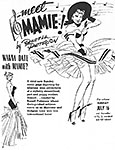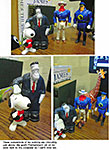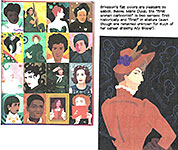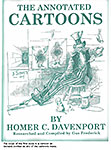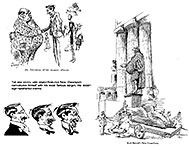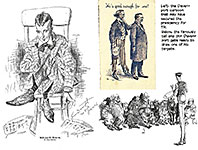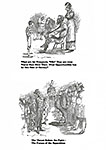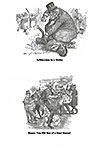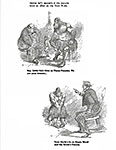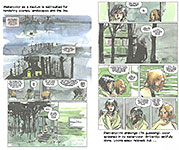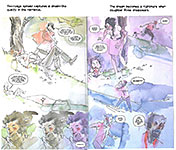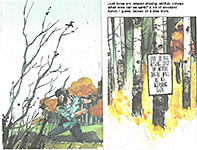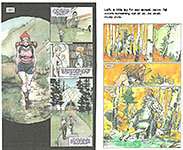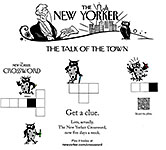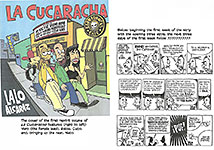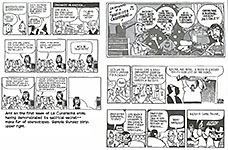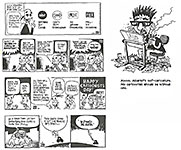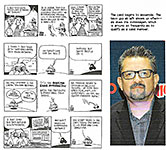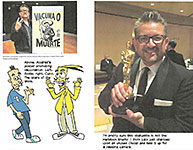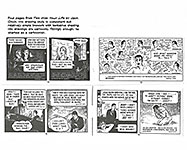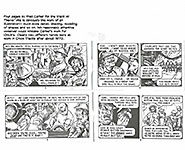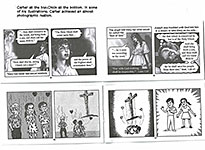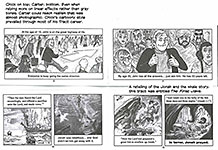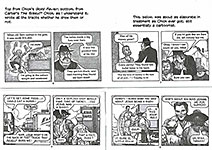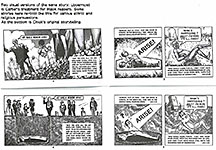 |
|||||||||||||||||||||||||||||||||||||||||||||||||||||
Opus 429a (June 29, 2022). We celebrate finishing our 23rd year with a roundup of recent editoons even as editooning is threatened, more mass murders enrage a nation, Florida governor vs Disney, reviews of Foul Play, Badass Broads, Davenport, Grass Kings, Lalo Alcaraz’s long journey, and Jack Chick’s ghost—and more, always much more. If you’re a non-$ubscribing visitor here, taking advantage (as we encourage you to) of our Open Access Month, you might consider wandering from the Rancid Raves posting at hand to look at some of the evergreen articles of history and biography in Harv’s Hindsight. Here are a few (look them up by date)—: Hubris & Chutzpah, the Al Capp/Ham Fisher Feud that Resulted in Fisher’s Death, January 29, 2013 Origin and Evolution of the “Comic Con,” November 30, 2017 Who Discovered Superman?, November 30, 2013 Unforgettable Jane (the British Comic Stripper), September 30, 2016 The Real Captain Easy, January-February, 2012 In order to assist you in wading through all this plethora, we’re listing Opus 429a's contents below so you can pick and choose which items you want to spend time on. An asterisk* marks the longest items. Here’s what’s here, by department, in order, beginning with the news of the day—:
MORE MASS MURDER —AGAIN AND AGAIN Bloody Month Editoons Spitzer Assault Weapons Are Machine Guns—and Machine Guns Are Illegal
THE SUPREME COURT HAS OFFICIALLY OVERTURNED ROE V. WADE NOUS R US EVENTS OF THE DAY CONTINUE TO THREATEN EDITORIAL CARTOONISTS * Editoonists Object to the New Catch-all Pulitzer Category AAEC Objects Past Winners Object NCS Objects Gannett Kills the Editorial Page Capitalists Not Journalists Run Newspapers Bookstore Being Sued for Selling Books Brewery Sued for Its Beer Label Chicano Cartoonist Alcaraz Wins Herblock Covering the New Yorker Clay Jones Wins RFK Award
FUNNYBOOK FAN FARE Reviews Of—: The Newest Shaolin Cowboy Wolverine Patch Batman: The Knight The Closet
EDITOONERY Selection of the Month’s Editorial Cartoons —* Including DeSantis’ Fight with Disney
NEWSPAPER COMICS PAGE VIGIL The Bump and Grind of Daily Stripping
TODAY’S COLLEGE STUDENTS ARE INDIFFERENT TO LEARNING
ACCRETION OF INTENTION DEPARTMENT Books In Need of Good Reviews—: * Foul Play! The Art and Artists of the Notorious 1950s EC Comics
RANCID RAVES GALLERY Pictures Without Too Many Words—: The Delicious Russell Patterson Consider the Giraffe
BOOK MARQUEE Short Reviews,to Wit—: Bygone, Badass Broads
BOOK REVIEWS Critiques & Crotchets and Long Reviews—: * The Annotated The Dollar Or the Man? The Issue of Today
LONG FORM PAGINATED CARTOON STRIPS Called Graphic Novels for the Sake of Status; Reviews Of—: * Grass Kings, Vol.1 and Vol.2
BADINAGE & BAGATELLES Lalo Alcaraz, La Cucaracha, the Herblock, and More —** The Long Journey of a Latino Political Cartoonist
PASSIN’ THROUGH * Fred Carter, the Cartoonist Behind Jack Chick
QUOTE OF THE MONTH If Not of A Lifetime “Goddamn it, you’ve got to be kind.”—Kurt Vonnegut
Our Motto: It takes all kinds. Live and let live. Wear glasses if you need ’em. But it’s hard to live by this axiom in the Age of Tea Baggers, so we’ve added another motto: Seven days without comics makes one weak. (You can’t have too many mottos.)
And in the same spirit, here’s—: Chatter matters, so let’s keep talking about comics. AND—
“If we can imagine a better world, then we can make a better world.”
And our customary reminder: when you get to the $ubscriber/Associate Section (perusal of which is usually restricted to paid subscribers but this time, it’s all Open Access, kimo sabe), don’t forget to activate the “Bathroom Button” by clicking on the “print friendly version” so you can print off a copy of just this installment for reading later, at your leisure while enthroned. Without further adieu, then, here we go—:
MORE MASS MURDER AGAIN AND AGAIN IT WAS ANOTHER BLOODY MONTH. The weekend of June 4-5 recorded 13 mass murders. Editorial cartoonists reacted predictably, as we can see hereabouts. Images of death and guns prevailed. Uncle Sam, chalking the outlines of dead bodies, a bullet-poxed national map, a baby in a hearse. Guns and killings in schoolrooms. Guns everywhere, Yosemite Sam with a vengeance—no longer a cartoon character. The terrible killing weapons of the 21st Century compared to the Second Amendmented rifles of the Revolutionary War. “Open carry” given a chilling translation.
Editoonist Kevin “Kal” Kallaugher adds the following text to his pictures of gigantic assault weapons in the hands of hunters: “New Zealand, the United Kingdom, Australia and Norway —all banned assault weapons after one mass shooting n their countries. This makes sense. These weapons are designed to kill a maximum amount of people very quickly. Any sane country would ban them. Take a hint, America.” But in this country, we still don’t ban guns: we make more of them. Annual domestic gun production increased from 3.9 million in 2000 to 11.3 million in 2020. There are about 400 million guns in the U.S. Our penultimate illo on this topic reproduces the Time magazine cover made up entirely of the names of places where this year’s 213 mass murders have taken place.
Said John Mavroudis, who created the cover: “In the time it took me to carefully write the words Uvalde, TX, that gunman extinguished so many beautiful lives. I could feel the sadness and fear and horror overwhelm me again.” Time’s editor-in-chief Edward Felsenthal added: “And just in the time it took that digital-first cover to go to print, the sadly unsurprising happened: those 213 shootings have already been joined by about three dozen more. “The bigger question, of course—far more important than what words we use—is what we as a society do. The gavel shape formed by the word enough on our cover is meant to signify the need for action. And that’s what the vast majority of Americans want. ... To try nothing in the face of routine massacre is unconscionable. As our cover asks, ‘When are we going to do something?’” Next to the Time cover, Adam Zyglis’s GOPachyderm holds a sign advocating for Pro Life, but blood spatters from gun violence have obscured the ‘f’ in ‘life,’ leaving only the ‘lie.’ Ain’t it the truth. Many states have passed laws making it easier to buy and carry concealed weapons. In 2011, only one state—Virginia—allowed “permitless carry”; but as of last month, The Week reported, 25 states do. Last year, 2,000 applicants were denied permits after background checks; now, all of them are free to carry concealed firearms. Meanwhile, just as we were going to post, the Supreme Court struck down a New York handgun-licensing law that required New Yorkers who want to carry a handgun in public to show a special need to defend themselves. So New Yorkers can carry at will. The 6-3 ruling, written by Justice Clarence Thomas, is the court’s first significant decision on gun rights in over a decade. In a far-reaching ruling, the court made clear that the Second Amendment’s guarantee of the right “to keep and bear arms” protects a broad right to carry a handgun outside the home for self-defense. Going forward, Thomas explained, courts should uphold gun restrictions only if there is a tradition of such regulation in U.S. history. Gun-control advocates say allowing unregulated carry of weapons (concealed or not) endangers police and the public, and there are statistics to back that up. One study found that gun homicides in Wisconsin rose by a third after a right-to-carry law was passed in 2011. In Missouri, gun homicides rose by 47 percent and gun suicides by 24 percent after the state repealed its licensing law. And yet a national Quinnipiac survey in 2019 found that 77 percent of Americans—including 68 percent of gun owners—back mandatory gun licensing. Ironically, we don’t need any new laws banning assault weapons. Our old laws do that just fine, thank you very much. They’re already on the books, as Robert Spitzer tells us—:
Guns Were Much More Strictly Regulated in the 1920s and 1930s than They Are Today By Robert J. Spitzer Distinguished Service Professor and Chair of the Political Science Department at SUNY Cortland. His most recent book is Guns Across America: Reconciling Gun Rules and Rights, published by Oxford University Press. THE FIRST SIGNIFICANT FEDERAL LAW AIMED at curtailing gun violence, the National Firearms Act of 1934, enacted a series of measures aimed mostly at stemming the spread of ever-more destructive weapons into the hands of criminals at a time of spiraling gangland violence. Chief among the weapons and accessories it regulated were sawed-off shotguns (defined as those having a barrel shorter than 18 inches), machine guns, and silencers. As if to punctuate the connection between the law and criminal violence, the NFA was signed into law on June 26. Bookending the signing was the killing of the notorious criminal duo Bonnie Parker and Clyde Barrow on May 23, and of uber-gangster John Dillinger on July 22. Yet the campaign to staunch the flow of such weapons into society began in the states the previous decade, when at least 27 states enacted measures to restrict or outlaw the sale and possession of fully automatic weapons prior to 1934— most especially submachine guns like the Tommy gun (dubbed “the gun that made the Twenties roar”). The first state to so act was West Virginia in 1925. ... Not only did states move to restrict fully automatic weapons— those that fire a continuous stream of bullets when the trigger is depressed— but also semi-automatic weapons that fire without reloading and with each pull of the trigger. At least seven, and as many as ten, states enacted legislation that in various ways sought to restrict such weapons. Sometimes, fully automatic and semi-automatic weapons were treated in the same way. For example, Rhode Island defined prohibited “machine guns” to include “any weapon which shoots automatically and any weapon which shoots more than twelve shots semi-automatically without reloading.” A 1927 Massachusetts laws defined prohibited weapons as, “any gun or small arm caliber designed for rapid fire and operated by a mechanism, or any gun which operates automatically after the first shot has been fire ... shall be deemed a machine gun.” Michigan’s 1927 law prohibited machine guns or any other firearm if they fired more than sixteen times without reloading. Minnesota’s 1933 law outlawed “any firearm capable of automatically reloading after each shot is fired, whether firing singly by separate trigger pressure or firing continuously by continuous trigger pressure.” ... As is true in much of life, changes in technology often drive changes in behavior. While the typical hunter of the 1930s might have used a bolt action rifle, today’s hunter is much more likely to rely on some kind of semi-automatic long barrel gun. Even if the hotly disputed category of “assault weapons” were banned nationwide today (as was true to a limited degree from 1994-2004), the vast majority of long guns owned and used for recreational purposes would still be legal. But what is notable, even astonishing, about the state laws just quoted is that they demonstrated little patience for semi-automatic firing married to the ability to fire multiple rounds without reloading. ****
By 1937, federal officials reported the sale of submachine guns in the U.S. had nearly ceased. In 1939, the U.S. Supreme Court ruled the law constitutional. The law so effectively ended the spread and use of submachine guns that the federal government didn’t get around to actually banning civilian ownership until 1986. That’s right: assault weapons are banned in America. Machine guns are assault weapons.
****
What weapons are illegal in the US? Machine guns. Sawed-off shot guns. Explosives and bombs. Stilettos. Switchblades. Other illegal knives. Is 3-round burst illegal? A 3-round burst is legal only if you have the gun registered with the Feds as a fully automatic firearm. There is the binary firing system that the Feds have decided is legal. It shoots once on the trigger pull and once on the release of the trigger.
**** After the ban on automatic rifles was enacted in 1994, the number of mass murders and deaths by guns deceased; when the law expired in 2004 and selling and owning such weapons was legal again, the number of killings increased. What other proofs do we need as to what causes mass murder? AND, most significantly, we don’t need a new law prohibiting the sale and possession of automatic and semi-automatic assault weapons. With that 1989 law that bans machine guns, we have the law already on the books. Let’s enforce it.
******
Last Minute, Breaking News Just As We Tossed This Into the Web THE SUPREME COURT HAS OFFICIALLY OVERTURNED ROE V. WADE And Justice Thomas suggests several other hugely consequential rulings could be next. By Bredan Morrow at TheWeek.com; June 24, 2022 Justice Clarence Thomas joined the court's other conservative justices on Friday in eliminating the constitutional right to abortion in the United States. Justice Samuel Alito wrote the majority opinion, but Thomas also wrote his own concurring opinion, in which he argues the justices "should reconsider all of this court's substantive due process precedents, including Griswold, Lawrence, and Obergefell," adding that "we have a duty to 'correct the error' established in those precedents." In 1965, Griswold v. Connecticut established a constitutional right for married couples to access contraceptives, while the 2003 ruling Lawrence v. Texas said states may not ban sodomy, and 2015's Obergefell v. Hodges established the constitutional right for same-sex couples to marry. The Supreme Court in overturning Roe v. Wade undid nearly 50 years of precedent, also overturning Planned Parenthood v. Casey, which in 1992 upheld the constitutional right to abortion. Thomas in his opinion argued the court was correct in holding "that there is no constitutional right to abortion" and that "the purported right to abortion is not a form of 'liberty' protected by the Due Process Clause."
*******
Back up — what did the opinion say? The specific case before the court — Dobbs v. Jackson Women's Health Organization — pertained to a Mississippi law banning abortions after 15 weeks of pregnancy, much earlier than the fetal viability threshold established by Roe. In siding with Mississippi on Friday, writes the Wall Street Journal, the court's six conservative members deemed the Roe decision to be "egregiously wrong" and "an error the court perpetuated in the decades since.” "We hold that Roe and Casey must be overruled," the majority wrote in its opinion, referencing 1992's Planned Parenthood v. Casey, which was also struck down. "The Constitution makes no reference to abortion, and no such right is implicitly protected by any constitutional provision … Roe was egregiously wrong from the start. Its reasoning was exceptionally weak, and the decision has had damaging consequences." "It is time to heed the Constitution and return the issue of abortion to the people's elected representatives," they added. Dissenting Justices Elena Kagan, Sonia Sotomayor, and Stephen Breyer just as potently rejected the majority's position. "With sorrow — for this court, but more, for the many millions of American women who have today lost a fundamental constitutional protection," the court's liberals wrote in their joint opinion: "We dissent." Is abortion now illegal everywhere? Not necessarily. In overruling Roe, the court has sent the issue of abortion back to the states, where its legality will be decided on an individual basis. Some states, like New York and California, have already codified the right to an abortion into law, and will be therefore largely unaffected by Friday's decision. But others, like South Dakota, Louisiana, and Kentucky, have laws that now immediately ban the procedure in Roe's absence. The same goes for Oklahoma and Texas. All make exceptions for the life of the mother. Elsewhere, in Idaho, Utah, North Dakota, Wyoming, Arkansas, Tennessee, and Mississippi, these so-called "trigger bans" — laws designed to come into play should Roe disappear — will take effect after 30 days, and/or after a state official certifies the court's decision. But in states without trigger bans — like Alabama, Georgia, Iowa, Ohio, and South Carolina — laws that forbid most or all abortions are likely to go into effect in the near future, the Washington Post notes. And in states like Pennsylvania, Arizona, and Virginia, the fate of reproductive rights "will depend on the upcoming midterms." *****
From USA Today: Today's decision does not mean abortion is illegal in all 50 states. But it does mean that people seeking abortion care will have to navigate a complex web of state laws that either protect or prohibit their right to choose. Across the South and parts of the Midwest, abortion is likely banned or more difficult to access. Meanwhile, North and Northwest states are poised to become havens where abortion rights are safeguarded. In 13 states, so-called trigger laws will go into effect following the Dobbs decision, immediately banning abortion in most instances with few exceptions for rape and incest, according to USA TODAY analysis. Some 16 states have codified the right to an abortion, and in 10 others, abortion rights have state constitutional protection. But even if abortion remains legal in a state, myriad restrictions constrain people's options and narrow their ability to get the procedure.
******
But the World Hasn’t Gone Completely Nutso Gene Popa on Carol Tilley’s Facebook: Do you know what brings me a glimmer of hope in the human species these days? Dmitry Muratov, a Russian journalist and Nobel Prize winner who disagrees with his country's invasion of Ukraine, put his Nobel up for auction in order to raise money to help shelter and feed Ukrainian refugees. He hoped to maybe get a couple of hundred thousand dollars ... and instead he raised $103.5 million! UNICEF now has the money, and they are putting it directly to work aiding refugees. So you see, we aren't all too damaged to do good. Thanks, Gene.
*******
NOUS R US Some of All the News That Gives Us Fits
EVENTS OF THE DAY CONTINUE TO THREATEN EDITORIAL CARTOONISTS
Editoonists Object to the New Catch-all Pulitzer Category The Pulitzer Board recently introduced a new category of achievement in journalism, Illustrated Reporting and Commentary. But by inventing a catch-all category that includes all kinds of illustrated journalism, they did away with the Editorial Cartooning category, subsuming it in the new catch-all category. And editoonists in the AAEC think that’s a mistake. We here at Rancid Raves agree. In an Open Letter to the Pulitzer Board dated in early May, AAEC explains better than we could—
The Association of American Editorial Cartoonists would like to congratulate illustrator Fahmida Azim and the other contributors to the team that created the illustrated article, “I Escaped a Chinese Internment Camp,” which won the 2022 Pulitzer Prize in the recently renamed category of Illustrated Reporting and Commentary. We would like to also congratulate the finalists, The New Yorker cartoonist Zoe Si, and Washington Post editorial cartoonist Ann Telnaes. Cartooning, regardless of genre, is time intensive, often challenging, occasionally dangerous, but always rewarding work. While we celebrate Azim, Si, and Telnaes, the AAEC once again encourages the Pulitzer Board to consider reinstating Editorial Cartooning as its own Pulitzer category, while also recognizing Illustrated Reporting as a separate form. Each is a different type of journalism, just as Commentary and Feature Writing are considered separate styles, and Breaking News and Feature Photography have separate Prizes. Editorial cartoons are quick, in-the-moment commentary, whose artists have to educate themselves on complex issues and craft well-informed opinions in a single take that emphasizes clarity under daily deadlines. Illustrated reporting, or comics journalism, takes days, weeks, or months to craft a story, which can run for pages, and which may or may not be presenting an opinion. By having two separate categories — one for Editorial Cartooning and one for Illustrated Reporting — the Pulitzers can celebrate what makes each genre unique, and recognize the growing field of graphic journalism without slighting the long history of political cartooning. The AAEC asks the Pulitzer Board to consider this proposal for the future. Signed, The Officers and Board of Directors of the AAEC
******* THEN the AAEC objection received an endorsement from dozens of past winners of the Pulitzer for Editorial Cartooning; to wit—:
Pulitzer Prize Cartoonists Pen Protest Letter to Pulitzer Board Ten days after the 2022 Pulitzer Prizes were announced, 33 cartoonists who have won or been finalists for the award in Editorial Cartooning signed an unprecedented open letter to the Pulitzer Board about recent changes to the Prize. After quietly expanding the parameters of the Editorial Cartoonist category in 2020 to include illustrators and graphic reporters, the Board that presides over the judging process for journalism’s biggest award renamed the category “Illustrated Reporting and Commentary” at the end of last year. This unannounced move came months after the Pulitzer Committee refused to pick a winner among the three qualified finalists in 2021, and 99 years after the “Editorial Cartooning” category was created. [See Opus 418a for June 2021for details.] Last week the AAEC sent a letter to the Pulitzer Board petitioning the restoration of the [Editorial Cartooning] award, and now almost three dozen recipients of the Prize are collectively seeking the same thing. Here is their letter (dated May 19) in its entirety.
Dear Pulitzer Prize Board— We are dismayed to see the Editorial Cartooning category removed from the annual conferring of Pulitzer Prizes. From America’s inception, the editorial cartoon has crystallized our messy political struggle. Iconic historic images — like Benjamin Franklin’s “Join or Die” woodcut, Thomas Nast’s plutocrat with a money bag head, and Herblock’s cartoon coining the term “McCarthyism” — all sprung from the minds of individual cartoonists drawing visceral, emotional, and urgent opinions, in response to the news events of their day. The greatest American editorial cartoons draw on every inch of the First Amendment to, as John Stuart Mill wrote in On Liberty, “push arguments to their logical limits.” For 100 years the distinguished Pulitzer Prize has walked hand-in-hand with the idiosyncratic editorial cartoonist, elevating the gritty public artform by (almost) annually bestowing its revered prize upon the “best” of the craft. This partnership has allowed publishers with intestinal fortitude to keep a seat for the local cartoonist on the newspaper editorial board, justifying their employment with the weight of the award. This has, without a doubt, nurtured the vitality of the medium and helped our nation weather its political discourse for the better. While the landscape of print journalism has changed, and far fewer practitioners of the [editorial cartoon] form are employees of newspapers, those newspapers still print scores of editorial cartoons every day. Added to that, there are now more editorial cartoonists than ever reaching their audiences directly via the digital screen. Our numbers are more stylistically, ethnically, and gender diverse. The conferring of a cartooning Pulitzer Prize continues to be a powerful affirmation of support, even more valuable for artists vying in today’s raucous public discourse. So, it is with alarm that we see the Editorial Cartoon prize morph into a nebulous award for “Visual Reporting and Commentary.” In journalism, reporting always emanated from a newsroom, and commentary from the very deliberately walled-off editorial opinion factory. This American tradition should not be watered down, and as we witness our country’s intensifying political divide, it feels like a dangerous moment to abandon us dagger-penned town criers. We fully understand the need to acknowledge and elevate important new forms of journalism, including powerful visual storytelling, like the ones you honored in 2022, 2018, and in 1992 when the Pulitzer Committee bestowed a Special Citation on Art Spiegelman’s Maus. But because these formats employ drawn visuals doesn’t mean they are the same as an editorial cartoon. Readers of the news have always treasured the quick and rude interlude offered by the ink-spattered rectangles nestled within the ocean of important words. And lest we forget, cartoonists draw our arguments using satire, a scarce commodity in journalism, but one that helps stick a message instantaneously and memorably in ways even the finest writing cannot. We mock the powerful, reduce tyrants to sniveling caricatures and twist demagogues’ own words against them. A serious illustrated reporting piece serves a notably different purpose. As grateful beneficiaries of the Pulitzer’s gravitas, we agree with the Association of American Editorial Cartoonists’ plea to restore the original Editorial Cartooning prize while also — as is done for multiple writing and photography categories — retaining the new prize created for Illustrated Reporting. In 1922, the first Pulitzer Prize for cartooning was awarded to Rollin Kirby for his “The March To Moscow” of 1921 In 2022, We the Cartoonists hope to continue our march with the Pulitzer Prizes still at our side, with categories honoring all, fittingly. Respectfully and sincerely, The signers include past Prize winners Matt Davies (who won in 2004), Clay Bennett (2002), Mike Luckovich (1995, 2006), Joel Pett (2000), Walt Handelsman (1997, 2007), Signe Wilkinson (1992), Mike Peters (1981), Michael Ramirez (1994, 2008), David Horsey (1999, 2003), Adam Zyglis (2015), Jack Ohman (2016), Jim Borgman (1991), Steve Sack (2013), Mike Keefe (2011), Darrin Bell (2019), Ann Telnaes (2001), Matt Wuerker (2012), Kevin Siers (2014), Nick Anderson (2005), Ben Sargent (1982), Steve Breen (1998, 2009), and Mark Fiore (2010), along with finalists Lalo Alcaraz, Marty Two Bulls Jr, Ruben Bolling, Ted Rall, Tom Tomorrow, Rob Rogers, Robert Ariail, Jeff Darcy, Steve Kelley, Chip Bok, and Kevin “Kal” Kallaugher. Since the letter was sent off, more Pulitzer winners and finalilsts have signed on to the protest, including 2020 winner Barry Blitt and Pat Bagley, the longest-employed staff editoonist at a daily newspaper.
******* AND THEN, the National Cartoonists Society jumped in, objecting to the Pulitzer Board dissolving the Editorial Cartooning category. Here’s that letter from the NCS Board of Directors—:
June 10, 2022 Since 1946, the National Cartoonists Society has existed to advance the ideals and standards of professional cartooning in its many forms. To this end, the NCS board of directors hopes you will consider the following request. As an organization representing cartoonists, we are deeply concerned about the decision to retire the “Editorial Cartooning” category for the Pulitzer prizes. We appreciate that the Pulitzers are expanding the types of cartooning and art that are award-worthy. We have done the same with our own awards. However, just as “News Photography” and “Feature Photography” are different, “Illustrated Reporting and Commentary” and “Editorial Cartooning” are two distinct genres of work and should be separate categories. We ask that the Pulitzer Board officially retain “Editorial Cartooning” as its own category in addition to recognizing the category of “Illustrated Reporting and Commentary.” The skillset of each form of cartooning is distinct: illustrated stories select a topic and are produced over an extended period of time, requiring a level of cohesion, research, and development unique to this craft. Editorial cartooning demands an immediate [daily] interpretation and reaction to events in real-time, necessitating an ongoing awareness of complex and often unpredictable contexts. At a time when news cycles are smaller and smaller, this skill has become even more crucial. Combining editorial cartooning and illustrated reportage together into one category does a disservice to both genres. To us, the situation is like having a sprinter and a long-distance runner competing for a single gold medal because they’re both track and field athletes. We do not want to undermine the importance and skill of graphic reporting, comics journalism, or long-form [illustrated] reportage, nor take anything away from that category’s deserving winners and nominees. Additionally, we are not suggesting that you remove the category of “Illustrated Reporting and Commentary”; rather, we ask that a category for “Illustrated Reporting and Commentary” exist alongside a separate category for “Editorial Cartooning.” We believe both skillsets deserve to be recognized. The NCS urges the Pulitzer board to adopt this change or consider opening the discussion with us to explore further. The Board of Directors National Cartoonists Society (Est 1946)
**********
GANNETT KILLS THE EDITORIAL PAGE And Stabs the Editorial Cartoon in the Front By Rick Edmonds, Poynter, June 8 Beginning in the spring and accelerating this month, Gannett is cutting back opinion pages in its 250-newspaper chain to a couple days a week, refocusing what opinion is still published to local rather than national issues. The change is evolutionary, Amalie Nash, senior vice president for local news and audience development, told me [Rick Edmonds] in an interview. Experimental approaches in the same vein at papers like The Tennessean and Milwaukee Journal Sentinel date back as far as five years. A series of reader surveys and a task force of editors have persuaded her and other executives to recommend a new chain-wide pattern as part of Gannett’s push to make digital content its focus. Among findings supporting a new approach, Nash said, were:
◘ Readers do not want to be lectured at or told what to think. ◘ Routine editorials, point-of-view syndicated columns and many commissioned guest essays consistently turn up as the most poorly read articles online. ◘ Readers can find a range of opinions on hot national issues on the internet — so replicating that sort of content locally is a waste of time, space and budget. ◘ In the digital space, readers may not easily distinguish opinion pieces from straight news reports. ◘ A more promising approach, as an April strategy document puts it, is “highlighting expert local voices that are not the same-old talking heads and political hacks.”
The new opinion program is a strong suggestion, Nash emphasized, but not an edict. Editors at individual properties are free to tailor the general principles to what they think best suits their community. [Still, cutting back editorial pages to once-a-week is the implied command. And the absence of an editorial page means, for most papers, no editorial cartoons, already gasping their last.] ... I received tips or complaints from a half-dozen retired editors, who see the changes as a veiled cost-cutting move and abdication of the principle that a newspaper needs to stand for something and say so regularly. ... More objections came from groups representing editorial cartoonists. At the Des Moines Register, opinion editor Lucas Grundmeier wrote: “Our emphasis will be on quality, not quantity, shifting to publication of a weekday opinion page on Thursdays only. Our current four-page Sunday section will continue.” And the remaining content will be local and even hyperlocal, he said, with a focus on solutions as well as identifying problems. Nash also offered, as an example, changes at the Columbus Dispatch, “which had a pretty traditional seven-day a week editorial page.” A new opinion and public engagement editor, Amelia Robinson, has flipped all that. She wrote in an introductory column in December that she sees her mission as “being able to provide platforms for the exchange of ideas … I see myself as a conversation facilitator.” ... Newsletters and video were being explored as adaptations for digital opinion journalism. Solutions journalism was finding its way as an alternative to the old ways, as David Haynes of the Milwaukee Journal Sentinel renamed what was his opinion section “Ideas Lab.” ... Gannett’s April strategy summary, headlined Opinion Content Recommendations, describes them as “research-backed ideas for a smarter, sharper, more constructive discussion, with our local news brands at the center.” That, at any rate, is the giant chain’s pitch. Whether news customers will be buying is about to be tested in real time in (pardon the expression) the court of public opinion.
**********
NEWSPAPERS LOSING MONEY The Gannett maneuver is clearly inspired by financial considerations. Newspapers these days are owned by hedge funds and other investment entities, and they demand profits that can be shared with investors. Newspapers can generate profit in one (or both) of two ways: increase income or reduce expenses. Income can be increased in one (or both) of two ways: increase circulation (buying customers) and/or advertising. Neither is likely in the Internet Age. People get their news from the Web; and the greatest advertising source of income was classified ads, which the Internet has hijacked away from daily newspapers. In short, newspapers have lost both of their traditional was of generating income. The only remaining way to turn a profit, then, is to reduce cost. One of the ways newspapers do that is by reducing payroll/staff. Newsroom population of reporters has been drastically reduced in recent years. And the reduction continues. Cutting back editorial pages helps reduce cost even further. Much of the editorial content is supplied by syndicated columnists for the use of which papers pay a fee; thus, papers save money by reducing the number of columnists (which, in this case, is done by reducing the number of editorial pages per week). And another consequence of reducing the number of editorial pages is the practical elimination of editorial cartoonists. Staff positions will be gone, and fees for syndicated cartoons will be nearly eliminated outright. The over-all quality of daily journalism suffers. Fewer reporters, less news; ditto for the editorial page. Journalism is dying. But today's newspapers are not produced by journalists. They’re produced by capitalists. The "journalists" of yesteryear— starting with the owners of many newspapers— were motivated as much by a desire to wield power as by journalistic principles. Political power. Newspaper owners wanted to influence their communities. Today's owners aren't interested in community welfare or the power to alter community welfare. They're interested only in the bottom line. The pursuit of power inherent in newspaper ownership of yore had, as a by-product, good journalistic practices. That doesn’t mean newspapers were objective in reporting the news. They may have been—in this department or that, depending upon the owner’s interest—but at least they were fact-based. Newsstories about events in the community had to be fact-based: if they weren’t, readers would know, and they would lose confidence in the newspaper. The greater the confidence the reading public feels about its newspaper, the greater the influence the paper has in the community. Thus, the more fact-based reportage, the greater the circulation and, perforce, the owner’s civic power. But bottom-line newspapering isn’t interested in facts or community power. It is interested only in the bottom line. That’s newspapering today. And it’s been going on for too long, but is not likely to change.
BOOKSTORE BEING SUED FOR SELLING BOOKS By Kelly Jensen at bookriot.com Right-wing groups are pushing a narrative that suggests public schools are at the epicenter of a a carefully programmed indoctrination, forcing gender and sexuality onto young people starting in kindergarten. And reaction has gone beyond schools. In early May, a Virginia lawyer filed suit against the Barnes & Noble store in Virginia Beach. It started with the schools. Virginia Beach schools voted to remove Gender Queer from shelves after school board member Victoria Manning complained about it and several other books within the schools. Following an initial review of the book, Manning appealed the decision made to keep the book and after reconsideration, the book was pulled. Now Virginia Beach attorney and State Delegate Tim Anderson posted on Facebook that he and his client Tommy Altman— a right-wing Republicon running for Congress in the Virginia Beach district— have asked the Virginia Beach Circuit Court to find “probable cause that the books Gender Queer and A Court of Mist and Fury are obscene” and must not be available to “unrestricted viewing by minors.” “My client, Tommy Altman, has now directed my office to seek a restraining order against Barnes & Noble and Virginia Beach Schools to enjoin them from selling or loaning these books to minors without parent consent,” reads Anderson’s post. No longer is this about the rights of students to access books. It’s now about the rights of private businesses to sell books. Anderson suggests this is a new avenue for parents to fight. “We are in a major fight. Suits like this can be filed all over Virginia. There are dozens of books. Hundreds of schools,” he said. Plenty of material to fuel Altman’s political campaign. Responses to Anderson’s announcement from followers encouraged such action and suggest this is just the beginning. Several have mentioned fighting such fights against “obscene” materials for months, maintaining that children should not be exposed to such obscene books. Still more comments applaud this brave move and see it as a way forward in book banning outside Virginia. Barnes & Noble has yet to respond to the legal actions taken. As a private business, they are not only allowed to sell what they wish to sell, but they are under no obligation by anyone to move materials out of their facilities. But lawsuits like this further fuel misinformation campaigns by these groups. Anderson’s announcement is more than tacit approval of Altman’s run for Congress. Anderson has made books a big part of his social media strategy and has riled up his base through it. Though this lawsuit includes only two books, Manning, the school board member who triggered the removal of Gender Queer, has her sights on Saga by Brian Vaughan next. She has been at the forefront of book challenges in Virginia Beach since the school year began, challenging The Bluest Eye for being “too racy,” despite never having read the book.
NOBODY’S SAFE By Emily Mikkelsen, Nexstar Media Wire In
North Carolina, a Maryland-based brewery sued about its beer label. A court
ruled in favor of the Flying Dog Brewery, a craft brewery that filed a lawsuit
against the North Carolina Alcoholic Beverage Control Commission, calling its
regulation allowing the ban of labels commissioners feel are “undignified,
immodest or in bad taste” a violation of the First Amendment. The label, illustrated by artist Ralph Steadman, depicts a naked cartoon character standing by a fire. The NC ABC rejected the beer because commissioners thought its label was in “bad taste.” The agency later allowed the beer to be sold. In a news release, Flying Dog stated they believed that this was not only a case of “appointed bureaucrats trying to impose their views and preferences on others,” but the regulation was unconstitutional in general. “The First Amendment is the last defense against authoritarian and arbitrary government, and it must be protected against any and all threats,” said Jim Caruso, CEO of Flying Dog Brewery. “With the First Amendment seemingly under attack from all sides, it is heartening to see court decisions like this that protect the freedoms that it embodies.” Flying Dog is no stranger to lawsuits about their beer labels, having won similar lawsuits in Michigan and Colorado as well. A federal appeals court ruled in favor of the brewery in 2015 regarding a ban of the sale of its Raging Bitch beer in the state of Michigan, news outlets reported. The dispute began in 2009 when a board determined the label to be “detrimental to the health, safety, or welfare of the general public.” The label featured a drawing of a female dog with accentuated features, bared teeth and a tongue covered in blood.
CHICANO CARTOONIST ALCARAZ WINS HERBLOCK By Emily Leopard-Davis at Al Dio The Herblock Prize for excellence in editorial cartooning was awarded to Lalo Alcaraz for his work in 2021. Alcaraz is the first Latino to receive the Herblock Prize. The prize is named after Herbert Block, an editorial cartoonist from the Washington Post whose career spanned from World War II to the first year of George W. Bush’s presidency. Block won numerous Pulitzer Prizes during his career, including one for Public Service on the Watergate scandal. The Herblock Prize has been handed out annually since 2004, three years after Block’s death. Alcaraz
is a Mexican-American editorial cartoonist based in San Diego. His editoons
have appeared in many different publications, including Daily Kos and Al
Dia News. He is also the creator of La Cucaracha, a Latino-focused
daily syndicated comic strip and POCHO, a satirical website. La Cucaracha is the first political Latino comic strip to be nationally syndicated and has
been running since 2002. Alcaraz’s cartoons have been featured in galleries, publications, television, and documentaries. He has several books out, including Migra Mouse: Political Cartoons on Immigration and Latino USA: A Cartoon History, 15th Anniversary Edition. Alcaraz is currently the Visual Artist In Residence for the School of Transborder Studies at Arizona State University. Most recently, he has used his cartoons to combat vaccine hesitancy among Latinos, partnering with CovidLatino.org and the California Department of Public Health. One of his vaccine cartoons, Vacunao o Muerte (Vaccine or Death), was cited by the judges’ statement. The piece is a homage to the protest poster by Emanuel Martínez, Tierra o Muerte (Land or Death). For more about Alcaraz and his creations and productions, scroll down to Badinage & Bagatelles near the end of this posting where we go on at Great Length about Lalo and his work.
COVERING THE NEW YORKER The week’s news, which often inspires the cover art at The New Yorker, was too horrible for pictures. Nineteen children and two adults dead by a shooter’s hand Tuesday at Robb Elementary School in Uvalde, Tex. And yet, despite the emotional impact, Françoise Mouly, the magazine’s art editor, had to ask herself: could there be an artistic response that would capture how devastating America’s latest mass shooting is? “Fortunately, artists do try to channel their emotions and reach for the wordless forum of the cover” of The New Yorker, Mouly told Michael Cavna at the Washington Post. “Many sent sketched responses combining blackboards, empty classrooms, apples, flags, guns and bullet holes.”
When New Yorker editor David Remnick saw Drooker’s scrawled shapes, Mouly recounts, he knew: this is the one. The cover art, titled simply “Uvalde, May 24, 2022,” was chosen, Cavna says, “not only for its concept but also for the power of its rendering.” Said Mouly: “The rawness of the execution makes for a visceral image. The rough outlines catch something of the pain and rage we all feel — about the fact this would happen and would happen again and again.”
CLAY JONES WINS RFK Editoonist Clay Jones was presented with the 2022 Robert F. Kennedy Human Rights Cartoon Award on May 24 for efforts created in 2021. Said the RFK organization on recognizing Jones: “Cartoonist Clay Jones deftly and courageously covers the themes of human rights and racial equality throughout his work. His uniquely energetic style makes him a standout.” [“Uniquely energetic style” is one way of saying “manic madness and stunningly, energetically, antic” artwork. Jones reminds me that “cartoon” once referred to crazy looking objects and objets d’art. Any time you want to remember the good stuff, pause to ponder a Clay Jones cartoon, which puts the frantic in antic and makes us all smile: even if the topic is dead serious, the pictures can’t help but make us grin in joyful relaxation.] Founded by the reporters who covered Robert F. Kennedy’s historic 1968 presidential campaign, the Robert F. Kennedy Journalism Awards honor outstanding reporting on issues that reflect Robert Kennedy’s concerns, including human rights, social justice, and the power of individual action in the United States and around the world. In accepting the RFK, Jones went on at some length, as follows—: I promised a few friends and cartooning colleagues I would get around to creating a post of my RFK award-winning entry. I still feel weird saying that. Each editorial cartoon contest requires a certain number of cartoons in an entree. The Pulitzer, Herblock, and RFK each require 15 cartoons. All the rest require less. It's extremely difficult to select 15, or fewer, of your best from over 300 cartoons [produced in a year]. And the RFK is special. While most of the other contests want your best, the RFK wants your best on a specific subject, human rights. I love that about this organization as human rights is my main focus. Some of these cartoons got me suspended on various social media platforms. Then Jones posted the cartoons he submitted to the contest; and we post them near here, all 15 of them.
Jones continued: I can't thank the Robert F. Kennedy Human Rights organization enough. I'm now on the list with the likes of Don Wright, Mike Peters, Paul Conrad, Clay Bennett, Mike Luckovich, Matt Davies, Doug Marlette, Signe Wilkinson, Dan Perkins, Jen Sorenson, Mark Fiore, Jack Ohman, Davi Horsey, Darrin Bell, Mike Thompson, Stephanie McMillan, J.D. Crowe (last year's winner), and Herblock. Whoa. I came into this business looking up to these people. I still do. I was told the name of a couple of cartoonists who were in the running with me this year and they're also people I greatly admire. So again, whoa. This award means the world to me. It only took me 32 years to win a national award. I also want to thank everyone who's ever supported me for helping me get here. From colleagues in Mississippi, Honolulu, Virginia, and other locations who've commissioned cartoons from me, to CNN, to everyone at GoComics, to all my newspaper clients, to people who comment, like, and share on social media, to everyone who's contributed financially, bought a print, or a book, to everyone who views and comments here, to the family members who still talk to me (even my older MAGA sister who told me I "wasted my talent"), and even to those who've criticized, thank you. I hope you know how much your support has meant to me. It's so rewarding knowing my insane crazy style of weirdness has finally been validated. You rock.
ODDS & ADDENDA
☻ Funny Times, a monthly cartoon tabloid newspaper, has been in business for 37 years, its most recent issue tells me. The cartoon content is mostly gag cartoons (sample posted nearby) with a few editoons thrown in. The rest of every issue is newspaper columns by humorists. Subscriptions at FunnyTimes.com start at $28 for 1 year (“Best Value” $68 for 3 years).
Fascinating Footnit. Much of the news retailed in the foregoing segment is culled from articles indexed at https://www.facebook.com/comicsresearchbibliography/, and eventually compiled \into the Comics Research Bibliography, by Michael Rhode, who covers comic books, comic strips, animation, caricature, cartoons, bandes dessinees and related topics. It also provides links to numerous other sites that delve deeply into cartooning topics. For even more comics news, consult these three other sites: Mark Evanier’s povonline.com, Alan Gardner’s DailyCartoonist.com (now operated without Gardner by AndrewsMcMeel, D.D. Degg, editor); and Michael Cavna at voices.washingtonpost.com./comic-riffs . For delving into the history of our beloved medium, you can’t go wrong by visiting Allan Holtz’s strippersguide.blogspot.com, where Allan regularly posts rare findings from his forays into the vast reaches of newspaper microfilm files hither and yon.
FURTHER ADO Awe. The feeling of being in the presence of something vast that transcends your understanding of the world. Awe stops us in our tracks. It makes us confront our smallness and puts us in our place. It expands our frame of reference. And it helps us look outside of ourselves.—Karen Einisman, quoting Dacher Keltner and Jonathan Haidt
FUNNYBOOK FAN FARE Four-color Frolics An admirable first issue must, above all else, contain such matter as will compel a reader to buy the second issue. At the same time, while provoking curiosity through mysteriousness, a good first issue must avoid being so mysterious as to be cryptic or incomprehensible. And, thirdly, it should introduce the title’s principals, preferably in a way that makes us care about them. Fourth, a first issue should include a complete “episode”—that is, something should happen, a crisis of some kind, which is resolved by the end of the issue, without, at the same time, detracting from the cliffhanger aspect of the effort that will compel us to buy the next issue. A completed episode displays decisive action or attitude, telling us that the book’s creators can manage their medium.
JEFF DARROW’S SHAOLIN COWBOY is back for another series, Nos.1 to 7. This is the hero, you’ll remember, of Chinese or other Oriental origins who seldom speaks but spends whole issues fighting and, eventually, overcoming the odds against him in fisticuffs. In the first issue of this new series, the opening pages are given over to a vaguely bellicose conversation between two lizards, a father and his son (whom the father wishes to devour). Then one of the lizards spots the Cowboy off in the distance, walking through the desert in cowboy hat and umbrella, and decides to attack. He does so. For the second fight of this issue, the Cowboy uses the blanket he has draped around his shoulders as a weapon: you’ll recognize the towel-snapping the Cowboy does with it in the playful hostility that usually infects the traditional locker-room hostility, but here, the snapping is part of a life-threatening battle between the Cowboy and another prehistoric beastie, this one of the flying sort—a rhamphorhynchus.
Through it all, the Cowboy hangs steadfastly onto his parasol. The Cowboy is not a particularly likable person. But that may be the story’s fault: we see him only fighting, not much opportunity for character development. But in both the episodes of this issue, he demonstrates resourcefulness, an admirable trait if not a friendly one. This would be boring stuff were it not for the detail with which Darrow infects his renderings. Watching the drawings is the most rewarding of the pleasures this title affords.
WOLVERINE
IS BACK AS PATCH, a guise involving a patch over his left eye from whence he
derives his name. In Larry Hama’s story as drawn by Andrea Di Vito and Le Beau Underwood, he’s now living incognito in Madripoor. I’m looking
at No.2 in the series and I can’t remember why he’s incognito, but I’m not sure
No.1 ever told us. In the issue at hand, we witness Patch being assaulted by
various thuggish elements—with arrows that turn Thanks to his “healing factor,” Patch is able to survive all these assaults. Meanwhile, a line-up of hostile adversaries plot their own activities—the Yakuza, the Russians, bow-wielding native tribes, KGB agent Tatiana Nemikova, snobby General Coy, the tattooed men, and Nick Fury shows up with an eye-patch of his own. Obviously, I am unable to make any sense of these fragments being thrown at us every other page or so. But I like the whole notion of Wolverine wearing an eye-patch and calling himself Patch. He did this in an independent series some years ago, and I liked it a lot. So I have hope.
BATMAN: THE KNIGHT No.1 is yet another in the seemingly endless re-tellings of the Caped Crusader’s origin story: teenage Bruce Wayne witnessing the murder of his parents and, subsequently—much later—resolving to combat crime as a costumed avenger. It seems that everyone who has ever thought about doing a Batman story has his/her highly eccentric “take” on this worn-out fable. So now Chip Zdarsky has his turn. Zdarsky
adds a tiny wrinkle here, a little twist there, but it’s still the same story.
But this time, we must endure Bruce being treated by Hugo Sessions with Strange alternate with Bruce’s “adventures” developing his combat skills and other things. These episodes reveal him to be stubborn to a fault: he’s set on becoming a cop, and nothing will dissuade him from this goal. If the story is thematically repetitious, Carmine di Giandomenico’s artwork is stunning in its detail and impressive in narrative breakdown. And Ivan Plascencia’s coloring is superb. Anytime I felt myself falling asleep, the visuals quickly revived me.
TO ESCAPE FOR A MOMENT from the universe of superheroes, I picked up the first issue of The Closet, written by James Tynion IV and drawn by Gavin Fullerton. The opening sequence takes place in a bar, and we watch as a customer regales the bartender with his tale of woes—he and his family are leaving town, and his son Jamie has irrational fears of a monster in the closet. When the guy gets home, his wife berates him because he has misinterpreted what she asked him to buy and bring home, and after that row, his son wants to sleep with him where he’ll feel safe from the monster in the closet. But that’s not to be.
The story succeeds because of Fullerton’s artwork. In the monotony of the bar sequence where the setting and the characters’ placement in it is unchanging, Fullerton varies camera angle and distance to inject visual variety and, hence, some excitement into the proceedings. And that’s fine. And in the sequence with Jamie in his darkened room, seeing a monster, Fullerton’s art carries the whole show. It’s dark and gloomy, and the panels are narrowly focused on what Jamie is experiencing, so we get into his head. Nicely done.
QUOTES & MOTS Always wondered what the rest of this verse was; here ’tis—: But as Froggy was crossing a silvery brook, Heigho, says Rowley! A lily-white Duck came and gobbled him up, With a rowley-powley, gammon and spinach, Heigho, says Anthony Rowley! “Gammon and spinach”—what a great finish!
EDITOONERY The Mock in Democracy OUR FUNCTION IN THIS DEPARTMENT is to draw attention to the imagery that editoonists deploy to express opinions about current events. One of those “events” involves the right of a woman to determine how her body should function (or not) which seems about to end, if the leaked Justice Alito memo is to be believed. With the overturning of Roe v Wade on June 24, we learned how accurate Alito’s memo was. But we’ll focus here on the weeks before the Supremes’ decision was announced, when editoonists were responding to Alito. According to the imagery of editoonist Ratt at the upper left in our first array of cartoons, the right guaranteed by Roe is slowly crumbling away—leaving nothing behind but “woe.” Nice word play. Going counterclockwise (counter, that is, to our usual practice), we see in Mike Luckovich’s cartoon a glimpse of that “woe”—the difficulty in finding an abortion clinic in a state somewhere near your own.
Then at the right, Pat Bagley offers a sarcastic vision of Supreme Court justices who, during their confirmation hearings, said Roe was “settled law” but who, when on the bench and faced with a case requiring a decision, decided to scrap this “settled law.” Clearly, the wanna-be justices were fibbing in order to get confirmed. What kind of justice are they likely to promote? Dave Whamond at the upper right shifts our attention slightly to the population most affected by scrapping Roe. In two panels, he reveals the cynicism of red-capped MAGA women who want the right to own guns but don’t care that other people are determining what happens to their unborn children. The illogic inherent in this situation is confounding: protecting the right to life of the unborn seems contradictory to protecting the right to own and operate death-dealing assault weapons. In our next visual aid, we begin at the upper left with Joe Heller’s happy imagery dramatizing the inspirational effect upon young Black girls of the appointment to the Supreme Court of a Black woman, Ketanji Brown-Jackson. Next around the clock (back to our customary rhetoric) is Pat Bagley’s image showing the kind of war crime Putin is inflicting upon the Ukrainians. Children are dying by the hundreds as he bombs schools, hospitals, apartments and other places where large groups of people can be killed. And they are all civilians; according to the rules by which warfare is supposed to be conducted, civilians are not to be targets.
Rob Rogers also focuses on the Ukraine War. In his comic strip, each panel shows a reasonable reaction to the destruction being inflicted by the Russians. But in the last panel, Rogers attacks NATO for ignoring the death and destruction because Ukraine is not a member of the alliance. This is a bureaucratic not a humane response to the situation. Then Jimmy Margulies’s image tells us why we (NATO? USA?) should become involved in the Ukraine situation: that country is likely just the first target for the guns of Putin’s tanks as he seeks to revive the Russian empire by “taking back” independent countries that were once part of Russia. Next, he’ll try to take, say, Lithuania or Latvia or ...? In our next array, editoonists consider the consequences of Putin’s invasion of Ukraine. Michael Ramirez starts us off with a horrific picture of Mariupol in total ruin. The Russian invader says they’ve “saved Mariupol from Ukraine,” but there is absolutely nothing left of Mariupol. Russia’s current strategy is to bomb successive Ukrainian towns and villages into rubble, which raises a provocative question: if Russia should win this war by bombing Ukraine into oblivion, what’s the point? What has Russia gained? Just real estate of rubble. And what use is that?
Next, Pat Bagley’s image shows the Russian invader up to his wrists in Ukraine. Clearly Russia is in over its head—or, at the least, is in a predicament it hadn’t anticipated. Then Bill Bramhall keeps score with a picture of Death addressing Putin while they both ignore the corpses littering the landscape in their wake. And then Rob Rogers offers a chilling picture of the consequences of ignoring a war criminal for decades: Rogers has pictured the Ukrainian civilians who, according to report, have been killed by the Russians, who first, before shooting them in the head, bind their wrists behind their backs (presumably to prevent resistance to murder). In our next collection of images, Tom Tomorrow (aka Dan Perkins) takes us into This Moderm World where nonsense prevails (but looks an awful lot like today’s reality, which is its satiric point). Although seeming to take comic strip form, it actually isn’t: the panels are not instances in a succession of related instances. Each panel here is virtually a stand-alone example of idiotic comment by which Perkins exposes actual idiocy. In a comic strip, the panels are related to one another, each leading to the next until arriving at the climax.
Below at the lower left, Wiley Miller’s comic strip Non Sequitur shows how contemporary events have infiltrated the fictional world of the funnies, an allusion to Will Smith’s now infamous slap at the Oscars. At the upper right, Phil Hands shows the Grandstanding Obstructionist Pachyderm playing with a chess piece while its supporters clamor behind it; the real pawns in the game, however, are school children, if we are to judge from the image of the pawn in the Pachyderm’s hand. Suspecting that we need a break from such heavy-duty thinking, I’ve included Bill Schorr’s deliberately sexist giggle at the lower right.
WE’RE BACK IN THE CLASSROOM for the next visual aid, beginning with Rick McKee’s exploration of the idea of arming classroom teachers as a way of preventing mass killings at schools. McKee translates the situation into something silly, but as a former classroom teacher myself, let me say nothing could be less workable than arming teachers: generally speaking, nothing in teacher training or personality suggests these people would be comfortable or even mildly competent handling guns.
Next, Daryl Cagle’s imagery connects the speech balloon’s remark to schools; otherwise, the verbal content is its own satirical comment. Then Adam Zyglis puts us back in the classroom with today’s lesson scrawled on the blackboard, but the shell casings on the floor reveal what kind of past he’s talking about, and repeated classroom killing shows how little we’re learning from our history. And then Christopher Weyant uses two panels to ridicule the Republicons for their preoccupation with such minor matters as CRT and sexual orientation classes when faced with the dire consequences of school shootings. At the upper left of our next display, Drew Sheneman shows the kind of weapons people were talking about when they wrote the Second Amendment.
Next around the clock, Rob Rogers reminds us how long it’s been since we’ve urgently demanded laws needed to control access to firearms. To his caricature of Lyndon Johnson, Rogers adds: “President Biden is not the first president to demand action on firearms in the wake of a tragic massacre, and, sadly, he won’t be the last. Until we find the energy and fortitude to vote out the gun-loving NRA-owned Republicans in Congress, the bloody cycle will continue.” Then Matt Davies suggests we’ve arrived at a “tipping point”—a term usually indicating a change is about to take place. But as his image reveals, that’s not the tipping he has in mind: instead, it’s the money the NRA contributes to politicians. And, no—change is not about to happen. Finally, Guy Parsons offers a little drama that enacts our reluctance to learn from factual evidence all around us. Nation’s that have fewer guns in circulation have fewer deaths by guns. Duh. The idiocy is perpetuated in Gary Markstein’s image in the next array: the NRA and the GOP offer “thoughts and prayers” in the wake of the last mass murder, but they’re also the proprietors of the Guns R Us store, which urges more gun sales and less control.
In a gun culture like ours, as Bill Bramhall demonstrates in the next editoon, everyone is in favor of encouraging more guns. Then Gary Varvel shows why we’ve made such little progress: our political parties can’t agree on the problem, let alone the remedy. Next, Dave Fitzsimmons creates an image that includes comment on a number of issues: that’s the Trumpet, of course, and he carries around his supply of NRA donations while announcing how irrelevant are his actions after a shooting. And now, it’s definitely time for another break—this time, a longer one—from our grim preoccupation with serious political and societal issues. Here goes—:
GAG CARTOONS (to deploy the technical in-house term for them) are supposed to be just funny. No political agenda for a gag cartoon. Well, usually. But sometimes a little social commentary edges its way into a fun-loving gag cartoon, and—suddenly—the cartoon acquires satirical heft and social import. And that’s true here, among the ’toons selected for viewing during this break.
Gag cartoons with political content are not inferior to ordinary fun-filled gag cartoons. They’re all equal as long as they provoke laughter or a gentle smile. Okay: enough fooling around. Back to the serious stuff.
WE COME AT LAST to Florida governor Ron DeSantis, who has supplied editoonists with material for months. He began by criticizing schools for teaching all that “woke” stuff—actual history of the U.S., for instance, particularly the white population’s role in perpetuating racism by building it into all our institutions (i.e., “critical race theory,” CRT)— which is what Pat Byrnes’ image ridicules at the upper left of our next array. In Byrnes’ image of DeSantis as school teacher, DeSantis displays an astonishing opposition to teaching about equality (of the races, presumably).
He’s holding a math book, reminding us that in Florida, according to one recent report, 54 of 132 math books failed Florida’s unwoke test (almost half, 41%). Racial prejudice and emotional learning are just two of the many "prohibited topics" cited as "impermissible" by the Florida Department of Education (FLDOE), which offered four examples of how teaching math “indoctrinates” students. In one example, if a textbook mentions “racial prejudice”—without saying whether it’s good or bad—then it’s indoctrination. Just mentioning it. DeSantis began his tirade against common sense by re-opening schools and beaches and other public places, thereby defying various health care regulatory bodies that had instituted mandatory mask-wearing and other restrictions. Then he signed a law—Parental Rights in Education, dubbed the “Don’t Say Gay” law— that uses “vague but menacing language” to ban any classroom instruction about “sexual orientation or gender identity” in kindergarten through third grade, thereby tapping into ignorant fears that teaching about sexual orientation and the like is indoctrination and promptly converts kids into being gay or transgender. Fox News host Laura Ingraham reacted by saying that public schools have become “essentially grooming centers for gender-identity radicals.” To which Michelle Goldberg at the New York Times responded: that’s right—the QAnon conspiracy theory that Democrats are “a cabal of pedophiles has gone mainstream.” DeSantis will have none of it. But it’s not clear what he can do about it short of railing at his presumed opponents. And an unsigned editoonist creates a comic strip at the right which seems to get into DeSantis’ head about all such issues, showing him to be a compulsive whiner. Then at the lower left, Nick Anderson sums up DeSantis’ achievement in making Florida “the most embarrassing state in the union.” Then Disney got into it. Disney, which has supported LGBTQ employees and causes, denounced the “Don’t Say Gay” law. And the company is nothing to sneeze at in Florida. With its massive theme park in Orlando, Disney World, Disney is the state’s largest employer with about 80,000 workers, and it brings billions in revenues to the state. The company announced it would suspend all political donations in Florida. DeSantis, however, was not to be intimidated. He signed legislation stripping Disney World of a special agreement that gave the company certain tax exempt status with the creation of the so-called the Reedy Creek Improvement District that enabled the company to build Disney World. Without Reedy Creek, there might not be a Disney World near Orlando, Florida. Alas, DeSantis’ revenge upon Disney was not without a certain backlash: DeSantis and his Republicon backers apparently did not calculate how disastrous revoking Disney’s special status might be for Florida taxpayers. Under its special arrangement, Disney heavily taxed itself, in effect, through Reedy Creek, funding upkeep for the roads, sewers, security, firefighting and other public services needed for Disney World. If Disney’s special status is revoked, Florida taxpayers will have to come up with the $163 million Reedy Creek has been collecting each year for those services. DeSantis claimed that wouldn’t happen, but it’s by no means clear to me or any of the rest of our Rancid Ravers. But when Disney took on DeSantis, editoonists chortled in delight: now they had an excuse to draw Mickey Mouse, making him the imagery of the company in its spat with DeSantis. In our next visual aid, Andy Marlette gets us started by employing other Disney characters, Winnie the Pooh and Piglet, to represent DeSantis’ effort to rid Florida classrooms of anything remotely resembling sex education. After that, the images are all Mickey.
Dick Wright shows what happens when Mickey sticks his finger in the electric socket of politics. Then Clay Bennett’s grinning cat represents the quarrel with DeSantis, showing it chewing on Mickey. After that, Adam Zyglis’ Mickey is just the mouse that the elephant is frightened of—the mouse with a sign proclaiming LGBTQ rights. On the next array, DeSantis’ ability to get himself on magazine covers and otherwise in the public eye is too great an opportunity for me to pass up so I’ve clipped and pasted. (The more visible DeSantis becomes, the more valid his hope to run for Prez.) And Tom Stiglich draws a perfect Mickey—this time, trapped in a perfectly rendered mouse trap.
Then Ruben Bolling finishes off this segment using a parody of Peanuts (“Q-nuts,” ‘q’ being the letter after ‘p’) to systematically ridicule the “Don’t Say Gay” law, culminating with an appearance in the strip of the world’s most famous cartoon character.
After that, we need another gag cartoon break.
THE ARTWORK carries a heavier load in a gag cartoon than it does in, say, a comic strip. Or so it seems to me. If you can’t determine pretty fast what the picture is about, then the caption that’s supposed to make sense (or poetry) of it won’t work. Take for example Vlad’s Body Piercing at the lower left of the first of our assemblages near here. What are those pointy things enclosed behind Vlad’s fence? Rockets? Spears? Because I’m baffled by what they are, I lose the rhetorical momentum: puzzling, baffled, I’ve forgotten what the joke’s about, and it’s lost.
And is Frank’s wife carrying Frank’s luggage? Or her own? On the next page, we begin with J. Kastner’s giant picture. Sometimes a gag cartoon is just a humorous drawing. That’s what this is. But in true cartoon fashion, the humor is lost without the caption that runs across the top. And in the Garybucks gag, that’s not a picture of a Garybuck behind Gary is it? It’s too big for that. So the joke here turns on Gary’s egocentricism. And below that—okay, it’s a bird at the bar, maybe, after reading the caption, it’s a chicken, but that derives from the caption, not the picture. Enough. Back to work.
A ROW OF PICTURES suggests, at first glance, some sort of progression: we’re intended to go across the row to a conclusion. And that’s what we do with Dave Whamond’s comic strip at the beginning of our next display. We progress through a short series of negative pronouncements until we reach the conclusion, which reveals with an image of prehistoric man in the background, just how retrograde the GOPachyderm’s ideas are. The Republicons want to live in the past.
Tom Tomorrow offers a progression, too. This Modern World often does not, but this time, it does: the last panel is, indeed, a “conclusion,” the outcome, to which the others have been leading, progressing, from one absurdity to the next, each one more idiotic than those that come before. Pat Bagley’s progression at the lower left is but a series of pronouncements, and the last one is a conclusion to which the words have been leading; the pictures add little except to identify the speaker as a Republicon. Switching back to the lower right, Steve Benson’s message is all picture. The Republicon elephant’s tusks seem, at second glance, to be Ku Klux Klan hoods. Yes, Steve doesn’t like the GOP much: he sees the Grand Old Party as a collection of bigots. Tom Stiglich musters a quiet homage to the soldiers in our history at the upper left of our next visual aid. Then Walt Handelsman finds an appropriate image that makes the connection between Biden’s releasing some of the Strategic Oil Reserve in the midst of spiraling gas prices and his hopes for improvement in his standing in the polls.
And Nick Anderson’s imagery portrays the Grandstanding Obstructionist Pachyderm as determinedly so anti-Biden that it can’t see any kind of big fish except the kind that threatens life and limb. Yes, it’s clear that Biden can do nothing right: everything he does is wrong. He’s condemned by the news media as well as the GOP. His reputation, his achievement, is so deliberately overlooked as to be essentially and entirely negative. I don’t see it that way, but I’m sure that’s a factor of my liberal leaning that blinds me to his shortcomings. At the lower left, John Darkow’s image of Elon Musk’s taking over Twitter is not likely to inspire confidence: Musk claims he’ll promote free speech, but so far, all we see is a lot of birds fluttering in hopeful anticipation. Dave Granlund begins our next array with an image about the economy: it seems that in our current state, we cannot afford to leave home for a vacation.
Next around the clock, Matt Wuerker’s imagery strenuously suggests that the judge that threw out the mask mandate for airplanes and public transport isn’t qualified to make that judgement: the image is of a crowd of people (scientists) opposing a single individual, the judge, who has dumped health guidelines and ignores the assembled expertise of the scientific community. Then Drew Sheneman uses two panels to question the extent of the Pachyderm’s dedication to the cause of Freedom: the elephant frees all of us from the mask mandate but will not free women from the obligation to give birth if pregnant. Kevin Siers also deploys two panels but to different purpose: he shows how the Republicon Party has been taken over by the Trumpet whose well-known silhouette signals that the brain in the Republicon head has been replaced by Trumpism. Trump is again the target as we begin our next display. Rick McKee shows the Trumpet mooning the statue of Justice, an image of contempt that confirms the headline in the newspaper box.
And Bill Bramhall’s image of Trump again has him exposing his naked backside as an expression of contempt. Then Dave Granlund closes this array with two images: the first, a picture of the Statue of Liberty—a symbol of America—declaring the achievement of a goal for women’s soccer, equal pay; the second is a quiet celebration of Mothers’ Day by a mother who is serving in the U.S. military in some land far-flung enough to require that the celebration be conducted through the mail. APO on the box tells us that it was sent via the Army Post Office. Time for another break.
AS ALWAYS, the captions explain the pictures, producing comedy. Mostly. The comedy in some of these gag cartoons comes close to evading me entirely. The motorcyclist turning into his mother? What’s that about? But the first cartoon—the package from Amazon that probably contains a Trojan horse filled with soldiers—is clear to me, but not terribly funny.
The next collection is, I ween, better. Funnier. I like the sound of one dog barking best. After that, the hummingbird and then the lumberjack’s response to the save-the-trees team. That cartoon and the clean-up on aisle 3 on the previous page veer off in the direction of editorial cartoons. And the clean-up, signed by an editoonist, was unquestionably produced as an editoon. Enough break. Back to work one last time.
THE OPENING CARTOON is Joel Pett’s examination of Mitch McConnell’s political philosophy. Pett cartoons for the Lexington Herald Leader in Kentucky, and that’s McConnell’s home state, so McConnell, one of Kentucky’s two senators, is a frequent Pett target. JEREMY: INSERT Edit(429a)16 SAME SIZE NOT THUMBNAILS HERE; THEN DELETE THESE CAPITAL LETTERS. In fact, McConnell appears to have no political convictions at all—except those that allow him to retain his power. That’s it. I’ve thought that for the longest time, and now I’m happy to have Pett, in effect, agreeing with me. Next is Mike Peters whose imagery quickly reveals that the pot is calling the kettle a puppet: Tucker Carlson is the puppet of Putin. Then Dave Whamond shows us that the American public’s fascination with sensational events leaves it too distracted to notice what is happening to its democracy, which is being stolen behind their backs. And then Pett is back with a picture of the cluelessness of the Kentucky state legislature, which apparently can’t see that no raises in teachers’ salaries probably causes many teachers to leave the profession, thereby creating the shortage. In our next collection, we ponder what several editoonists have to say about student debt. Pat Bagley’s 4-panel cartoon shows us a college graduate who, having tossed his cap into the air in celebration of his graduation, wonders what has become of it. And what is it? Is the cap a symbol of achievement? Or just of a diploma, nothing more. At the very least, having graduated, the graduate is puzzled to discover how little that achievement means.
And that is the truth. A college diploma is not a work permit, despite what many graduates believe. But prospective employers have invested the diploma with a significance that it doesn’t deserve in MHO. It is, however, a 4-year record of what a graduate has been doing— something a prospective employer can check on to learn what his prospective employee has been doing. That’s about it. A simple but useful record. We’d probably all be better off if employers weren’t so persnickety about demanding a college diploma as testimony to one’s ability to do a job. Fewer people would go to college, for one thing, which might have the effect of restoring the college diploma to its traditional value. And the whole college industry might collapse, taking with it great quantities of professors who are paid outlandishly high salaries for doing nearly nothing. And those who don’t go to college would find that it didn’t matter. Not in that happy new world without a plethora of diplomas. In the old world, the college industry rules. Employers demand that prospective employees have diplomas to prove—well, what? Everyone wants to go to college, and that keeps professors employed, doing nothing for high salaries. And graduates with diplomas learn that the diploma is not guarantee of getting the job you most want. Phooey. Well. Sorry. Got off on one of my high horses. And that doubtless colors my interpretation of Bagley’s editoon. Next around the clock, Walt Handelsman’s image shows us that a college diploma is no guarantee against having to snorkel your way around a massive student debt. Indeed, too many college graduates have loans to pay off, and that prevents them from entering into the economy fully and properly. And that, of course, is too bad but not tragic, earnest protestation to the contrary notwithstanding. Rick McKee gets at another aspect of the situation in 4 panels. Judging from sympathetic noises made by some elements of the population—not to mention some of the college graduates themselves—there is a growing sense that student loan debt ought to be forgiven outright in order to permit college graduates to enter the economy by marrying, buying a house, etc.—all of which makes the economy function better, closer to full capacity f’instance, which in turn improves the general welfare of the country. But—I dunno—what’s the word “loan” mean anyway? Why shouldn’t a loan be repaid? I think our economy simply must learn how to function with a significant number of persons who have to pay off their loans before they can enter fully into the life of the country. What’s wrong with that? That’s life, kimo sabe. Dick Wright offers a final word on the subject—a gleeful portrait of a couple of college grads whose debt has been relieved. What a relief! Wright’s picture doesn’t say how the miracle should be accomplished. But however it is, it would no doubt produce lots of images like this one. In our next collection, Bill Day’s image of the right-wing American eagle starts us off. I’m not at all sure what the right wing in Day’s drawing represents. Rigidity? Inflexibility? It’s a very attractive design, but how does it work in the rhetoric of the imagery? Best I can do: it represents a rigid, inflexible posture. The eagle looks a little pissed off—or puzzled. Can’t fly with a rigid right wing? Dunno: that may be reading too much into Day’s picture.
Tom Tomorrow’s Modern World addresses the war in Ukraine and Putin’s role with the usual roster of idiot Republicon speakers talking trash and ranging over the entire political landscape. Not an image in sight, but with Tom Tomorrow, imagery is not his vehicle. In his comic strip Pearls Before Swine, Stephan Pastis references the famous slap that Will Smith delivered to Chris Rock thereby animating the Oscar show more than anything else ever had. Nothing of great import; just an indication that comic strips these days sometimes go political—i.e., make references to contemporary American life outside the strip— which is where none of them went in ancient times. In present-day cartooning, obviously “the slap” is a great inspiration: it inspired at least two comic strips. And finally, Bill Bramhall creates an image that suggests that we’ll be seeing the politics that produced the Jan6 insurgency again from time to time; we seem unable to learn from our experiences, and Uncle Sam proves it by assaulting the wall with an aged axiom. Jan6 was itself a repetition of some previous anti-democratic maneuver. I don’t know who drew the opening editoon in the next array, but whoever did it created an image suggestive of the arrival of fascism—an armed and aggressive military-minded ruling class. The guy in the doorway is from the Texas Department of Family and Protective Services (the sign on the car door in the background), and his military uniform implies fascism. He’s sent by Texas governor Abbott, he says, and the sign on the wall inside the house—“I love my trans kid”—suggests that the fascist is going to try to take the trans kid away from his parents, trans kids being unacceptable to Governor Abbott. The arrival of fascism represents the disappearance of democracy and the triumph of an ascendant autocratic dictatorship.
Next, Jeff Danziger is having a little fun with Tucker Carlson’s recent statement about the need for men to tan their testicles. The image of a naked Carlson using a red lazer pointer to tan his balls is laughable enough that further comment is unnecessary. And then Gary Varvel’s image of a couple cancel-culture soldiers expecting that killing Jesus will silence his followers shows how ineffective cancel culture maneuvers are: killing Jesus as a historical act created more followers than he’d had before. To extend the logic inherent in that circumstance: canceling culture just doesn’t work. The picture of Carl Barks, duck artist supreme, is here at the lower left because Jim Engel’s picture is such a delight. The hats on the hatrack in the background are Donald’s and Uncle Scrooge’s, but the thing that makes me smile with pleasure is Barks’ visage as rendered by Engel. Great. Finally, in our next visual aid, a comment or two on the most recent of political events. First, Ed Wexler gets it “right” 100% in his characterization of right wing-nut objection to teaching actual U.S. history in schools (i.e., critical race theory, CRT): if teachers teach about frogs in schools, clearly they’re grooming the children to be amphibians. The logic, which is employed by right wing-nuts on the topic of CRT, is inescapable.
Then Walt Handelsman anticipates the Supreme Court throwing out Roe with an image of a highway making a sharp right turn, one missed altogether by the ProChoice folks in the bus going over the cliff. Unanswered is the silently posed question: what happens to those ProChoice folks now? Crash and burn anyone? And next, Joe Heller’s image of Putin as a fish in a bubble, wholly ignorant of how bad the war in Ukraine is going. And then at last, Jeffrey Koterba brings us up to the most recent event—our anticipation of the Hearings on Jan6. The ol’ eagle seems anxious rather than eager to see what transpires. And that, anxious rather than eager, is a telling motto for the next month or so as we await the unfolding of other events worthy of editoonists’ imagery.
THE FROTH ESTATE The Alleged “News” Institution SEVEN YEARS AGO The more we get to know Supreme Court nominee Samuel Alito, said Derrick Z. Jackson in the Boston Globe, the less there is to like. President Bush's choice to fill Sandra Day O'Connor's crucial swing seat on the court is not only on record proclaiming his disdain for Roe v. Wade, he’s also shown a frightening contempt for minorities, women, and civil rights. Alito, it was revealed last week, once belonged to the Concerned Alumni of Princeton, a reactionary group of white males that called the admission of women to that university an unfortunate 'fad' and groused that 'subpar’ minorities were being admitted to their fine alma mater. In a 1985 application for a promotion within the Reagan administration, Alito trumpeted his belief that 'racial and ethnic quotas should not be allowed,' and said he'd gotten interested in constitutional law because of his 'disagreement with Warren Court decisions.' The Warren Court, of course, was the Supreme Court that banned segregated schools, and expanded civil rights for millions of Americans. Is there a pattern emerging here? Quoted in The Week.
READ & RELISH Here at the Intergalactic Rancid Raves Wurlitzer... Theodore “Teddy” Roosevelt, who served as Prez from 1901 to 1909, was an adept coiner of phrases. It was he who invented the term “White House” as another way of referring to the executive branch. He also popularized “throwing one’s hat into the ring,” referring to running for office, and “muckrakers” for investigative journalists.
NEWSPAPER COMICS PAGE VIGIL The Bump and Grind of Daily Stripping SOMETIMES,
we pause on the funnies page of the paper just to admire, ever so briefly, some
tiny trick of the eye or some kind of visual antic. Nothing large but memorable
nonetheless. In our first examples are several such moments. In Blondie, the Bumstead family dog, Daisy, speaks in the first strip on display. But not, as most cartoon dogs do, in human verbal forms; instead, just dog talk—“woof” a few times. Nothing unusual about that, but three panels of Daisy reminds us that she’s always around. If the day’s action takes place in the Bumstead home, Daisy is likely to be in view (even if, as in the Sunday strip at the bottom of this page, only at extreme distance). Blondie fairly reeks with visual aspects worth noting. Dagwood makes regular visits to the barber, which often gives John Marshall and Dean Young an excuse to make a joke about those wildly sprouting strands of hair that spring from Dagwood’s head. At some distant time in the early history of the strip, these sprouts were ordinary aspects of Dagwood’s hair—just coming a little loose from a center part. In the office scene, Marshall and Young violate the strip’s enduring 3-panel format, giving Mister Dithers a double-wide panel in which to wreck havoc. The increased width emphasizes the power of Mister Dithers’ blow. And then in that Sunday strip, an oddity: in three panels, Blondie appears in extreme close-up, and because we’re “closer” to the artwork, the lines delineating her head and hairdo appear wider, bolder. Why does this seem to make sense? It does to Marshall, who draws the strip, so it must to us.
IN
OUR NEXT ARRAY, we post again the Rose Is Rose strip about National
Cartoonists Day. That’s May Fifth, which we explained in Opus 428a, a Bunny
Bonus. We’re including the strip here again to make up for failing to include
it again in Opus 428 even though we mentioned it when listing the contents of
that opus. And if you want to know about National Cartoonists Day, you need to
go back to that Bunny Bonus. And we’ve included Patrick McDonnell’s Mutts here because the joke is about cartoonists, which makes this posting all about cartoonists. And that brings us to Dennis the Menace, which we’ve posted several of because the drawings are cartoons (duh) and it’s the drawings that attracted our attention. In the first one, Dennis says that they’re out of towels, but—but he’s got one draped around him. So? The next two Dennises are notable for the amount of detailed artwork in the backgrounds of these two efforts. A new name has been cropping up in Dennis lately—that of Scott Ketcham, the son of the creator of the feature, Hank Ketcham. Scott signs “S. Ketcham,” as we see in the first two cartoons here, following the name Marcus Hamilton, who has been soloing on the daily Dennis for years. Scott occasionally draws the feature, but when his name is yoked to Hamilton’s, it probably signifies that he conjured up the day’s joke. The Sunday Dennis is done by Ron Ferdinand, and recently, he’s done a few of the dailies—the third panel in our display, f’instance.
A SUBJECT THAT HAS LONG BEEN TABOO on the funnies pages is religion. And any allusion to the Almighty. Not only was there an industry-wide prohibition, but most cartoonists realized, probably, that if they mentioned such things in their strips, it would provoke outrage among those who disagreed with the theology represented—or agreed. In short, no one would be laughing. But
hereabouts in our next visual aid, we have God mentioned and even depicted.
Probably coupling God to Google as Pig does in Stephan Pastis’ Pearls
Before Swine would be widely regarded as sacrilege of some sort. Pastis
doubtless got letters. In Rhymes with Orange, Hilary Price alludes to religion when she conjures up a scene on Noah’s ark, but in the next of her strips, she has God working on a laptop computer. Under normal circumstances, she’d be swamped with irrate protest letters. But the protest against deploying religion in comic strips has doubtless been muted lately because of a 288-page report of investigation into allegations of sexual abuse by members of the Southern Baptist Convention, who claimed clergy harassed and abused them and when they reported it, the SBC Executive Committee not only ignored their claims but sometimes attacked the complainer. Such events will have a tendency, I hope, of silencing the self-righteous among us. Alas, it won’t cure them; but it’ll shut them up for a while. And so Price will escape a deluge of protesting letters this time. Sex is another of the traditionally forbidden topics. And it is gently alluded to by Greg Evans in his Luann where Tiffany and her college roommates have a “private hut” in their apartment and are upset that one of their number seems to be using it all the time with her boyfriend. Constantly. At the very least, the hut hosts canoodling of a severe sort. Nothing that can be tolerated in a comic strip of yore. But today it seems, almost anything goes. In Baby Blues, Kirkman and Scott have the kid alluding to flatulence, another taboo of yesteryear.
IN
THE NEXT DISPLAY, the cartoonists feature a topic that, until very recently,
was taboo in newspaper comic strips—sex. Well, maybe the Sunday 9 And Ron Kirkman and Jerry Scott’s Baby Blues isn’t really about sex, but the kid is playing with his mother’s bra and that reminds us of boobs and that reminds us of sex. Or maybes it’s just us. Dana Summers’ Bound and Gagged isn’t about sex either: it’s about nudity, which reminds us of sex. The two guys pushing the car sideways aren’t supposed to be nude, but if you look at the way Summers has rendered their butts, it seems, for a brief moment, that they don’t have any pants on. He’s delineated their butt cheeks too precisely.
GOSSIP & GARRULITIES Name-Dropping & Tale-Bearing TODAY’S COLLEGE STUDENTS ARE INDIFFERENT TO LEARNING By several measures — attendance, assignments turned in late, quality of in-class discussion — today’s college student performs worse than any students Jonathan Malesic has encountered in two decades of teaching. The author of The End of Burnout, Malesic teaches first-year writing at Southern Methodist University and lives in Dallas. Students today don’t even seem to be trying, Malesic continues in an article in the New York Times. “I wondered if it was me, if I was washed up. But when I posted about this on Facebook, more than a dozen friends teaching at institutions across the country gave similar reports. Last month, The Chronicle of Higher Education received comments from more than 100 college instructors about their classes. They, too, reported poor attendance, little discussion, missing homework and failed exams. “The pandemic certainly made college more challenging for students, and over the past two years, compassionate faculty members have loosened course structures in response: they have introduced recorded lectures, flexible attendance and deadline policies, and lenient grading.” Many students got out of the habit of coming to class at all, Malesic says. And they got into the habit of living with much looser standards. The New York Times piece goes on for pages. It’s a devastating look at the college student. I don’t think college students, as a group, have ever demonstrated the passion for learning that countless thousands of teachers look for. But students were not as blatantly indifferent as they seem now according to the NY Times. So what’s happened?
ON THE ONE HAND, THE PANDEMIC has encouraged the educational institutions to accept looser standards—recorded lectures, flexible attendance and deadline policies, and lenient grading. In effect, less conscientious students have become acceptable—ostensibly for the duration of the pandemic but, then seemingly, for all time. In such a relaxed atmosphere, students stopped coming to classes regularly. Secondly, society at large is less intimidating, its structures and customs less inhibiting, so students get away with bad learner behavior. I suspect social media is to blame here. Social media makes explicit the opinions that once were mostly unexpressed, and, unexpressed, no one knew about them. So young people followed social custom. Then came social media. Suddenly, young people realized that millions of others shared their views, so there was no reason to follow the strictures of aged custom. I wonder if the increase of mass murders isn’t the result of the same phenomena. Human beings have always included a percentage of hateful people—bigots usually (and not just racial bigots). Social media have shown those bigots that they are not alone. And as they became conscious of seemingly vast numbers of their kind, they are less intimidated by social custom. And so they act out their feelings by shooting people they hate (without even knowing, in some instances, that the people they shoot are, indeed, the people they hate). I taught high school English for five years. Years later, I realized that one of the things I liked about teaching was the implicit demand that I be a performer, amusing and entertaining classrooms of students as well as attempting to teach them. I was the star of the show. Who wouldn’t enjoy such status? But I was also excited by the learning experience itself. And I think I learned that in a sophomore philosophy course in college. The professor had an unusual teaching method. I can seem him now—a short guy with a impish face. He’d enter the classroom and take his position—seated, cross-legged on the desk in front of the room. Then he’d start the “discussion” with a question. Hands were raised. He’d call on one of us. But he didn’t stop when the student seemed to have answered the question. Now that he was engaged with that student, he’d ask a follow-up question. And then another, and then another. Each question, provocative, each one, more and more so. As he and his captive student dug deeper and deeper into the topic. Meanwhile, the rest of us demonstrated an impatience to be called on. We’d start waving our hands in the air, clamoring visually for him to call on us because we knew, listening to the exchange between student and professor, that we could do better, we had a better answer. Eventually, having wrung out of his first “victim” all that he thought he could, the professor would pick another one of us. And the process would start again. What we were all looking for, waving our hands in the air, was the sense of achievement that came with answering a question “correctly” (although his questions didn’t have specific answers). Even if the prof’s method—subsequent questions, all addressed to whichever of us had responded first—suggested that there were no “right” answers, we were somehow persuaded that there were. So we kept on. And he, perched on his desk, grinning impishly, kept on, too. Obviously, the entire population of Earth did not attend his classes, becoming, willingly, his victims/learners. This story just dramatizes a little what happens to most people who become teachers/learners. They become impassioned to know “the answers.” Oh, well. Old gaffer complaining about the upcoming generation.
TICS & TROPES A silk-screen print of Marilyn Monroe’s face by Andy Warhol sold at Christie’s in May for a record $195 million, becoming the most expensive American artwork ever sold at auction. It was the second-highest auction price for artwork in history—just behind a $450 million Leonardo da Vinci. Well, it’s a difference of $255 million, which, in and of itself, is a greater sum than the price of the Monroe print.
ACCRETION OF INTENTION DEPARTMENT Books In Need of Good Reviews THE RANCID RAVES Book Grotto is littered, literally, with books we acquired with the intention of reviewing them. Alas, they’ve piled up over the years, and it has become increasingly apparent that we’ll never give most of them the kind of intensive examination they deserve. So rather than let the accretion be entirely in vain, we’ve started this new department wherein we’ll briefly describe books by way of urging them upon you, beginning, this time, with—:
Foul Play! The Art and Artists of the Notorious 1950s EC Comics By Grant Geissman 272 8.5x11-inch pages, color; 2005 Harper Design paperback, $29.95 THIS BOOK IS ABOUT EC HORROR COMICS. Not the war stories. Not the Mad parodies. (Although EC is notorious for both.) Horror. Horror and the artists who made EC famous for horror. And because Geissman has been hanging around EC Comics for more-or-less a lifetime, the book is liberally sprinkled with wild and wonderful minutiae as well as the larger narrative facts. Here, f’instance, is the cover of Shock Illustrated No.3 (Spring 1956), an issue that publisher William Gaines had destroyed right off the presses when it was apparent that he couldn’t afford to have the run of 250,000 bound. He couldn’t afford it because EC was slowly going out of business, thanks to the anti-horror movement that Fredric Wertham had set in motion. But Gaines had a couple hundred copies bound by hand for his files and to give the artists who produced them. And here is a complete never-before-published EC story—“Wanted for Murder,” which had been produced for EC’s Picto-Fiction Crime Illustrated in 1956 but never published because Gaines stopped publishing all the EC comics except Mad, which went on to save his business. Drawn by Al Williamson (with a little help from Angelo Torres), the story is presented as an illustrated text rather than the usual paneled pictorial narrative, comicbook style. The book is a happy scrapbook of Geissman’s love affair with EC. He has filled the margins of his book with historical trivia—like the letterhead of the Charles William Harvey Studio, the cobbled-up art studio name made up of the first names of the partners, Charles Stern, Bill Elder, and Harvey Kurtzman. That’s where the latter two got their starts in comics; Stern went on to another kind of career, not comics. And here are three panels that Wertham used in Seduction of the Innocent to show how bad the influence of comicbooks was. All drawn by Elder, who insisted that he was uncomfortable doing horror; he liked humor instead. Here’s Wallace Wood’s splash panel for Mad’s “Superduperman,” the parody that set the tone for Mad. And here’s a photograph of a nude drawn by Jack Kamen, a painting that hung for years in Gaines’ office at EC headquarters. Lots more like this.
AFTER AN INTRODUCTORY CHAPTER that tells a severely abbreviated history of comicbooks, the book is organized by the artists, beginning with Al Feldstein and Johnny Craig and going through Graham Ingels, Wallace Wood, and John Severin to get to Reed Crandall and Bernie Krigstein with Jack Davis, Jack Kamen, Joe Orlando, George Evans and Al Williamson and the Fleagle Gang (names here) thrown in along the way. The penultimate chapter treats of the artists who did at least one story for EC but are not reknown for their EC work—Sheldon Moldoff, Alex Toth, Basil Wolverton, Joe Kurbert. Oh, and Marie Severin, John’s sister, who did the coloring of most of the EC books. The last chapter reprints EC Christmas party art. Every chapter concludes with a complete reprint of a story drawn by the artist featured in that chapter. Elder’s chapter ends with “The Night Before Christmas,” Charles Clement Moore’s famous poem that Elder “illustrated” scandalously (so much so, that the issue of Panic in which it appears was banned in Boston as if Elder’s work was a sacrilege; it isn’t but it makes Santa appear to be divorced). And every chapter carries the signature of that chapter’s artist in the top margin, wondrously handy because so obvious a signal of the content of the pages as you thumb through. Thumbing through to get a feel of the book for this review, I came across odd fragments. Here’s a page of Wood’s Witzend magazine that he produced so artists would have a place that respected their best work—to which they would then submit their best work. Just one page and it’s reproduced too small to read. Elsewhere, the expression “a cup of meat” caught my eye. Not “cup of tea.” And here’s Kurtzman “abruptly leaving Mad.” Abruptly leaving? Why? Geissman doesn’t tell us; Kurtzman left Mad because Gaines wouldn’t give him 51 percent ownership, thereby giving him complete control of the magazine. For all the photographs herein, there is no picture of the building that housed EC offices at 225 Lafayette Street in lower Manhattan. On several of my intermittent trips to New York, I took photos of what I thought was this historic building. But finally, I realized that odd number addresses were on the opposite side of the street than I was photographing. And there were no vintage buildings any more on that side of the street. What buildings were once there had been removed to make room for a more modern structure. The building that served as EC Comics headquarters no longer exists. All we have now is books like this one. Enjoy while you can.
CLIPS & QUIPS Remember “Ride a Cock Horse to Banbury Cross”? What’s that about? Well, to “ride a cock horse” usually referred to straddling a toy horse or an adult’s knee. If that latter, it should be sort of jumping up and down gently.
RANCID RAVES GALLERY Pictures Without Too Many Words The
larger of these two images took a full page ad in Editor & Publisher for
June 3, 1950, to announce the debut of Russell Patterson’s exquisitely Mamie was usually fully dressed in the highest female fashions of the day; none of the strips I’ve seen showed her in a swimming suit or a bathtub. But each of the Sunday strips consisted of the comic strip and another kind of strip: called Mamie Models, it was a paper doll version of Mamie that you could cut out and dress with the clothing that surrounded her. In order to encourage you to dress her, she was standing there in her undies (as close to naked as she ever got) just waiting for you to cut out the attendant wardrobe and suit her up for the day. The smaller image in the accompanying illo was used in a one-column ad.
Consider the GIRAFFE, for example. A Darwinian theory of evolution posits that it was through random variation that some giraffes had longer necks than others. Thanks to their long necks, they were able to reach leaves high up in the trees in their environment. Because they could access food, the giraffes with longer necks were better able to survive and reproduce, with their offspring inheriting their long necks.
The giraffe’s long neck was an act of will, not evolutionary accident. Lamarck has long been discredited—alas. But I like to think that acts of will are important in evolutionary and human affairs, so I collect figurines of giraffes to remind me that we can sometimes determine our fates. At least, partially. My latest long-necked acquisition stands behind other figurines on my computer desk—Blackhawk and the Vigilante. And next to Vig is a strangely goofy Frankensteinish figure petting Snoopy on the head. I love ’em all.
PITHY PRONOUNCEMENTS Once you can accept the universe as matter expanding into nothing that is something, wearing stripes with plaid comes easy.—Albert Einstein What sane person could live in this world and not be crazy.—Ursula K. LeGuin
BOOK MARQUEE Short Reviews and Proclamations of Coming Attractions This department works like a visit to the bookstore. When you browse in a bookstore, you don’t critique books. You don’t even read books: you pick up one, riffle its pages, and stop here and there to look at whatever has momentarily attracted your eye. You may read the first page or glance through the table of contents. And that’s about what you’ll see here, beginning with—:
Bygone, Badass Broads By Mackenzi Lee; illustrated by Petra Eriksson 175 6x8-inch pages, color illos; 2018 Abrams Image hardcover, $19.99 EACH OF the 52 “forgotten women who changed the world” gets a 2-3 page write-up, plus a full-page portrait in solid colors with no lines, the stylish manner adopted by Eriksson. But it’s Lee’s prose style, conversational and witty, that won me over. Except for Lorraine Hansberry, the last woman in the book, I’ve never heard of any of these world-changing broads. Well, Marie Duval, “the artist behind Victorian England’s most popular cartoon” (Ally Sloper)—her, I knew. Lee’s introduction of Duval is typical of her attitude and wit: “Ally Sloper was created and illustrated by a man named Charles H. Ross. Except he wasn’t. All Sloper’s escapades were actually illustrated by Charles’s wife, Marie Duval, continuing the long artistic tradition of men taking credit for the work of women.” The woman with one of the longest names in the book, Elvira de la Fuente Chaudoir (1913-1995), Lee bills as “drinker, gambler, playgirl, spy.” Along the way, we meet Mary Anning (1799-1847), “the fossil collector who changed paleontology,” and Anne Lister s(1791-1840), “the first modern lesbian.” Not to mention Ching Shih (1775-1844), “terror of the South China Seas”—a pirate. “Ching’s first order of business was to issue a pirate code to ensure that any wishy-washy dipshits who weren’t keen on sailing under the command of a woman either behaved or bailed.” Her strict rules included “Rule 1: If any of her men raped a female captive, you better believe that dude was beheaded posthaste.” Followed, eventually, by “Rule 4: Desert your post? Ears cut off.” I borrowed this volume from the local library. I like it so much that I bought a copy for my library.
CIVILIZATION’S LAST OUTPOST One of a kind beats everything. —Dennis Miller adv. The Republicon Party has gone bull-goose bonkers. Its leaders have turned the once-proud GOP brand into an unprincipled gaggle of corporate profiteers, hatemongers and screwball conspiracy theorists. They’re so far out that the Hubble Space Telescope can’t find them!—Jim Hightower
BOOK REVIEWS Critiques & Crotchets and Long Reviews
The Annotated The Dollar Or the Man? The Issue of Today By Homer Davenport with annotations by Gus Frederick 114 7x9-inch landscape pages; 2022 Liberal University Press paperback, $20 HOMER DAVENPORT (1867-1912), one of the great names in American editorial cartooning, is at least the equal of Thomas Nast, whose working life Davenport’s overlapped for nearly a decade, roughly 1895-1902. But almost no Davenport cartoons (except his famous portrait of William R. Hearst) have been reprinted. Until 2006. But I didn’t know about it until seven years later.
We hopscotch the high points of Davenport’s life in Opus 367 (June 2017) while also reviewing the only significant collection of his cartoons that had been published at the time, the third edition (2013) of a 2006 reprinting of one of the two books of his cartoons published in his lifetime, Cartoons by Davenport (1897), with extensive annotation by Gus Frederick, who is also the publisher of the tome, under the name Press.LiberalUniversity.org. Frederick has re-titled this volume: The Annotated Cartoons by Homer C. Davenport (184 8x10-inch pages, b/w; 2006 Press.LiberalUniversity.org paperback, $20).
DAVENPORT BECAME FAMOUS during the presidential contest of 1896 by depicting candidate William McKinley’s manager, wealthy industrialist Marcus Hanna, wearing “plutocratic plaid” with a tiny dollar sign in each square, accurately pinpointing the real issues and interests of the campaign, the Trusts suppressing the poor. The cartoonist’s work was fierce enough on politicians that it inspired a failed anti-cartoon bill in the New York State Assembly. The bill was defeated but if passed, it would have severely limited the kind of cartoon that an editorial cartoonist could produce—certainly nothing critical of a politician. In 1904, one of Davenport’s cartoons of Uncle Sam with his hand on the shoulder of Teddy Roosevelt is said by many to have enabled TR’s election.
At the time of my 2017 review, Frederick was at work on the second Davenport book, which I wildly nagged him to continue his efforts on. And it has now appeared, The Dollar or the Man, originally published in 1900 and, like Frederick’s earlier reprint, extensively annotated by Frederick, who offers relevant background information about each cartoon, including photographs of the persons caricatured in them. Every cartoon gets two pages: a full-page reproduction of the work with a facing page text annotation by Frederick. “The oligarchs of the day,” says Frederick, “are easily recognized and of course the familiar bulbous form of ‘Dollar Man Mark Hanna’ returns, pictured as the controlling entity of the McKinley administration.” This collection introduces a new “character,” the Trust Brute, “a personification of the corporate trusts that took root during the Gilded Age.” In Davenport’s day, the term trust was used to refer to groupings of business interests with market power enough to become monopolies or near-monopolies. The Trust Brute, representing the raw power of the trusts, is portrayed by Davenport
as “bearded, hulking muscular monster, with a primitive grass kilt, often
carrying a whip or club. ... Like the Tammany Tiger and Uncle Sam,” adds
Frederick, “the Brute joins Davenport’s toolbox of hyperbolic personifications,
drawn to order.” Copies of the original 1900 book, The Dollar or the Man, are extremely rare, Frederick tells us. “Since McKinley and his administration were the main targets of the work, his death [by assassination] and the ensuing public sentiment no doubt cut into book sales,” which effectively reduced the quantity of the books that were preserved. In reprinting that volume (and its predecessor) with extensive annotation, Frederick has performed a monumental service for all students and fans of editorial cartooning in America, explaining who the victims of Davenport’s pen are and what their significance was at the time. This volume is smaller than Frederick’s previous effort, 114 pages vs. 184. And the orientation of the book is horizontal rather than vertical. While this works with many of Davenport’s cartoons, some have a greater vertical dimension, and these are reprinted herein by twisting the book sideways. Throughout, reproduction is superb. The original selection of cartoons is by Horace L. Traubel, who chose cartoons that “focused on the monopolistic corporate trusts and the increasing disparity between the few rich and the multitudes of the poor.” “Traubel was closely associated with the Arts and Crafts movement in the U.S. and published a monthly literary magazine called The Conservator from 1890 until the time of his death in 1919. Although a poet of note in his own right, Traubel is best remembered as the literary executor and biographer of his friend, poet Walt Whitman.” The second Davenport volume arrived in my mailbox just the day before a flyer arrived there announcing the Homer Davenport International Editorial Cartoon Contest, also shepherded by Frederick. The deadline for submitting cartoons is 5 p.m. Friday, July 29; grand prize is $750. For rules and entry forms, consult HomerDavenport.com/tooncon/ Entries in previous contests are posted at the website, including one from me—Entry 2 in the 2017 contest. No, I didn’t win anything. But with editorial cartooning, it’s how you play the game that counts; winning is impossible.
IRKS & CROTCHETS Most of American culture is high comedy of the most self-flagellatingly ignorant kind. While I understand the punchlines of most of it, one evades me entirely. Here it is: the people who are fanatic about their inability to tolerate abortion because of the precious lives of fetuses, the unborn, are the same people who will not tolerate at all any laws that prevent them from owning as many guns as they want—many of them, the sophisticated weapons that can kill 10-20 people in a minute. In the first instance, they’re against killing; in the second, they’re assiduously preparing to kill. So where, exactly, do these people stand on the matter of life and/or death? They stand on the Right, of course.
LONG FORM PAGINATED CARTOON STRIPS Called Graphic Novels for the Sake of Status
Grass Kings, Vol.1 Matt Kindt’s story drawn by Tyler Jenkins 190 7x11-inch pages, color; 2018 Boom Studios hardcover, $29.99 Grass Kings, Vol.2 Matt Kindt’s story drawn by Tyler Jenkins 190 7x11-inch pages, color; 2018 Boom Studios hardcover, $29.99 I STARTED WITH VOLUME 2, which is not the mistake you think it should be. Not much happens in Volume 2. Several individuals are trying to solve a mystery. And they go about it methodically but slowly. Their incidental conversation chews up pages. Then when I read Volume 1, Volume 2 started to make a kind of sense. Just exactly what you’d expect. These books were published initially as magazines, which are bound together to make “books” out of them. The books include the covers of the magazines, opening each new issue as a “chapter.” The Grass Kings are three brothers—Robert (a drunk), Bruce, and Ashur—who “own” (they claim, not without dispute) their land, the Grass Kingdom, on the other side of the lake; their family has owned the land since World War I (1918; not such a long time as time runs). The brothers protect its borders fiercely, fanatically. No uninvited intruders. And no dependence upon any governmental entity. The closest town is across the lake, Cargill, where Sheriff Humbert wants jurisdiction over Grass Kingdom. Robert’s drinking is caused by his grief over the death of a daughter and the behavior of his wife, Amber. The daughter, Rose, just disappeared one day; and she was the center of the marriage, so it began to fall apart, each of the parents blaming the other for the loss until neither could take it anymore. Humbert’s wife Maria swims out to the Grass Kingdom and is taken in by Robert. Humbert sends Big Daniel out to the Grass Kingdom to find her and bring her back, and when he finds her, she shoots and kills him. Then Humbert goes looking for them both and gets into fight with Bruce, the Kingdom’s lawman. He leaves but swears he’ll be back, which he does with a bunch of deputies, and a gunfight ensues, evolving quickly into full-scale war with bombs and tear gas and the like. When Humbert finds Maria, she shoots him. Wounded, Humbert is helped out of the Grass Kingdom by Robert. After that, Robert goes to the town of Raven, where his wife Amber lives. He visits her in order to tell her that he finally assumes his share of blame for the disappearance of their daughter, Rose. But the parents cannot re-unite: as Amber says, “When I see you, Robert, I see her,” and it’s too painful. They part. Bruce visits Humbert, and they talk about a serial killer still on the loose—the so-called “thin air killer.” Humbert believes the killer resides in the Grass Kingdom. And as Bruce ponders this, the book, Volume One, ends. The ending is both a conclusion to Robert’s agony over the loss of his daughter and a springboard to Volume 2, which now makes more sense to me: Robert and Bruce and the rest are searching for the serial killer than Humbert says lives in the Grass Kingdom. Or is he just saying that to rattle Bruce’s cage?
VOLUME 2 BEGINS WITH BRUCE AND ROBERT wondering whether Humbert is right about a murderer living in Grass Kingdom. They realize they don’t know their population as well as they thought they did, and so they go visit the writer Hemingway, who is writing a history of the Grass Kingdom. Turns out, he came to the Kingdom by following the trail of the “thin air killer.” So maybe Humbert is correct. Bruce and Robert discuss two murders: one in Raven, of a well-to-do son of a rich guy, who was found strangled and stripped; the other, a school teacher, Jenny Handel, who died in a fire in her cabin. Now they think maybe she was murdered first. Ashur, Robert’s younger brother, and his buddy Pinball start investigating Jenny’s death. So they go visit the Satellite Sisters, Patch (eye patch) and Judy, orphaned twin sisters who run the Grass Kingdom’s security system. The boys see some old security tapes, tapes made at the time of Jenny’s death. Ashur steals one of the tapes and puts it in Robert’s mailbox. We meet Shelly, operator of the local junkyard. Maria tells of her husband, sheriff Humbert, working on some sort of case—files all over, Jenny Handel’s name on some. Humbert flew into a rage about her snooping, and she, finally fed up with his bad treatment of her, left. She’d heard about the Grass Kingdom, so she swam out there. Then we meet Archie, who, although faithfully married to Allison, lusted after Jenny. They had long midnight conversations by radio and they sent each other letters tucked into books they swapped. But this relationship never developed into an affair. Then one night, Jenny phoned in a panic. Archie, half drunk out of his mind, did his best to run over to her place, and when he got there, he found her hanging by the neck in a closet. She’d killed herself. Then Archie panicked: what if someone found all his letters to Jenny and made them public in an investigation of her death? Then his marriage to Allison would be destroyed, and he couldn’t bear that. He didn’t know where the letters might be and didn’t have time to look. So he set Jenny’s cabin afire, expecting all the letters would be destroyed in the blaze. Bruce and Shelly discuss it all, and Bruce, convinced Jenny died in a suicide, goes around and assures people that she died a suicide. But when he tells Humbert, the sheriff laughs. He has a coroner’s report, and it reports that Jenny’s hands were bound with plastic ties when she died. Couldn’t hang herself without use of her hands. Humbert promises to do nothing with this evidence if Bruce gets Maria to return to him; if he doesn’t—if she doesn’t—then he’ll turn all his evidence over to the feds, and the resulting investigation will probably destroy the Grass Kingdom. Bruce tells Robert all of this, and Robert beats him up for a fool and vows to do whatever is necessary to save the Kingdom. End of Volume Two. Volume Three is apparently out, but I haven’t got it yet. When I get it, I’ll report on what the ending to this grass saga might be.
APART FROM THE TANGLED WEB of Matt Kindt’s tale, we have the pleasure of watching Tyler Jenkins’ pictures. These are line drawings that are water-colored. Every page is a series of paintings. Feast your eyes.
BEEFS & BOFFOS Remember the 10-year-old girl at Robb Elementary in Uvalde, Texas, who smeared herself with her dying friend’s blood so the shooter would think she was dead and leave her alone? What kind of a country are we in which 10-year-old girls know about smearing blood on themselves to foil a mass murderer? What kind of country?
COLLECTORS’ CORNICHE
AT THE TOP of the accompanying illustration is the masthead for the opening section of an issue of The New Yorker—“The Talk of the Town” section, which contains newsy and gossipy bits. The character depicted at the left is a version of Eustace Tilley, the magazine’s unofficial mascot. Eustace Tilley shows up every so often—once a year, usually, on the cover of the anniversary issue. But the character at the right, the owl, is never seen except on this opening page of the magazine. Until now. As you can see on the bottom half of the accompanying illo, the owl is now being employed with The New Yorker Crossword. Employed at last. Thank goodness: we don’t like to see a character hanging around with nothing to do.
BADINAGE & BAGATELLES Lalo Alcaraz, La Cucaracha, the Herblock, and More Lalo Alcaraz is an award-winning nationally syndicated editorial cartoonist and the creator of the syndicated daily comic strip, La Cucaracha, published nationwide since November 2002. In addition to the Herblock Prize, Lalo is winner of six Southern California Press Awards for Best Editorial Cartoon; he was an editorial cartoonist for The LA Weekly from 1992-2010. Alcaraz now creates editorial cartoons for Andrews McMeel Syndication, Daily Kos, Pocho.com and various newspapers, including Philadelphia’s Al Dia News. Alcarcaz is also a very funny and inspired satirist. Lists of his achievements attest to that, of course, but I want to drag in an incident I witnessed at a scholarly conference at which Lalo was a presenter with two others at one of the panel presentations—Ann Telnaes and Keith Knight. As the three of them sat at their table in front of the room, suddenly the lighted illustration that was projected onto the large screen behind them disappeared. No one had done anything to cause the disappearance. The light just went out. While the other presenters shook their heads in amazement, Lalo leaped to his feet, turned around and raised his hands and placed them against the wall as if he were to be frisked by police, a perfect enactment of the kind of scenario that often takes place between Chicanos and law enforcement. The room, of course, roared with laughter in appreciation.
AN ACCOMPLISHED ILLUSTRATOR AND CHICANO ARTIST, Alcaraz has had work featured in numerous museums, galleries and publications around the world and on broadcast television and documentaries. Lalo’s graphic novel and cartoon books include the New York Times bestseller A Most Imperfect Union; Latino USA: A Cartoon History, 15th Anniversary Edition; Migra Mouse: Political Cartoons On Immigration; and La Cucaracha. Alcaraz is a writer, producer and cultural consultant for film, TV and animation, including projects at Nickelodeon, Cartoon Network, Disney, Fox and Xbox. He was cultural consultant on the Oscar-winning animated Pixar film “COCO.” Alcaraz is also Cultural Consultant, Consulting Producer and Writer on the animated series “The Casagrandes” for Nickelodeon Animation. He is a former illustration faculty member of Otis College of Fine Art & Design. Alcaraz is active in using cartoons and animation to battle vaccine hesitancy and Covid misinformation in the Latino community with the organization CovidLatino.org and the California Department of Public Health. He is currently Virtual Artist In Residence for the School of Transborder Studies at Arizona State University. He is a graduate of San Diego State University (BA in Art) and UC Berkeley (Master's in Architecture). With the foregoing as preamble, we next take up Graciela Mochkofsky’s long biographical article at newyorker.com, to wit—:
Lalo Alcaraz and the Long Journey of a Latino Political Cartoonist Does winning a prestigious award mean that Alcaraz is now accepted by the mainstream? By Graciela Mochkofsky at newyorker.com, May 18, 2022 Like many prestigious awards that recognize great accomplishment in this country, the Herblock Prize for editorial cartooning, created in 2004 to commemorate the legacy of the late Washington Post cartoonist Herb Block, had never been conferred on a nonwhite person—until this year. [That’s not so surprising: apart from Alcaraz, there aren’t many nonwhite editorial cartoonists.—RCH] While accepting the prize at the Library of Congress on the evening of April 27th, Lalo Alcaraz, a Chicano from San Diego, California, said what many of his friends and followers were posting on social media: “It’s about time.” For the past thirty years, Alcaraz, who is also the first Latino political cartoonist to produce a nationally syndicated comic strip, has used a caustic, take-no-prisoners humor against anti-immigrant and racist public figures. “No other political cartoonist working in the U.S. brings as much passion, dedication and brilliance to the fight for fair immigration at the border and justice for the Latino community,” the Herblock judges stated. In 2020 and 2021, Alcaraz had been a Pulitzer Prize finalist in the editorial-cartooning category, but, last year, in a decision that outraged many cartoonists, the Pulitzer Board chose not to declare a winner and has since eliminated the category for editorial cartoons. (See Nous R Us for more on this topic.) The Herblock Prize, then, signalled a triumph for an artist beloved in the Latinx community but who, like the community itself, has long felt a lack of recognition from mainstream America. Now he has finally been accepted. Or has he? “I get a lot of hate mail,” Alcaraz said in his Herblock Prize acceptance speech. A few days later, during a Zoom call from Los Angeles, he told me, “There is still this American societal attitude that we are foreign.”
HE IS NOT, IN FACT, FOREIGN. The child of immigrants who moved to this country from the Mexican states of Sinaloa and Zacatecas, Alcaraz was born in 1964 in San Diego, a city, he told me, that was “in denial that it was on the U.S.-Mexico border.” He grew up witnessing and experiencing discrimination and racism—from cops pulling him over for no reason, when he rode his bike as a kid, to “shoplifting police,” following him and his mother in stores, to a large outdoor swap meet that ended with Border Patrol cars and helicopters chasing a group of undocumented immigrants as a crowd of horrified Mexican Americans watched. These experiences, he said, put “the politics of the border in front of my eyes.” That political awakening led him, as an undergraduate at San Diego State University, to join MEChA (Movimiento Estudiantil Chicano de Aztlán), a civil-rights student group founded in 1969. He graduated in 1987, with a degree in art focussed on environmental design, and completed a master’s in architecture, at U.C. Berkeley, in 1991. He started drawing cartoons seriously at San Diego State, and at Berkeley, he co-created a comedy group, the Chicano Secret Service, in which he performed at campus protests, and a satirical magazine called Pocho, which still exists as pocho.com. (Pocho is a derogatory term for Mexican Americans who have Americanized and lost their Mexican culture.) In 1992, soon after the L.A. riots, a friend introduced Alcaraz to Kit Rachlis, then the editor-in-chief of LA Weekly, an influential alternative magazine. Rachlis looked at Alcaraz’s work and, impressed by his “sardonic, pointed” cartoons, which, he told me, had “a sensibility taken from graphic novels,” offered him a regular spot. For that, Alcaraz created a comic strip, L.A. Cucaracha, which ran in the magazine until 2010 and, since 2002, has been nationally syndicated as La Cucaracha [“the cockroach”] in more than sixty newspapers. [Universal Press Syndicate considered La Cucaracha an unqualified success and signed Alcaraz to a ten-year contract.—Wikipedia] The main character, Cuco Rocha, Alcaraz has explained, is “such an angry Chicano activist that he turned into a cockroach.” Cuco is actually an anthropomorphized cockroach who, according to one reviewer, “comes off less Kafka and more Subcomandante Marcos” (the former leader of the Zapatista Army of National Liberation, a guerrilla group in Chiapas, Mexico). Cuco is joined in the comic by two regular humans, his best friend and alter ego, Eddie, and Vero, Eddie’s girlfriend. They are young, working-class, bilingual Chicanos, with a world view shaped by the enthusiastic activism sparked by Cesar Chavez and by the anger ignited by Proposition 187, a 1994 California ballot initiative that restricted public services, including health care and education, for undocumented immigrants. A review of past strips offers a catalogue of anti-Latinx episodes. In one, from June, 2016, Cuco reads from his smartphone to Eddie: “Trump called a Mexican judge who is going to rule on the Trump University fraud case ‘a Mexican’ and ‘a hater of Donald Trump.’” Eddie replies, “Wow. Openly Mexican judges.” (Alcaraz’s Twitter name is Mexican Judge.) Cuco adds, “Next thing you know, they’ll want to use our bathrooms.”
THE COCKROACH “IS A SYMBOL FOR CHICANOS,” Alcaraz said, which derives from two sources. One is Chicano literature and art, including the classic The Revolt of the Cockroach People, by Oscar (Zeta) Acosta, a roman à clef, published in 1973, about the rise of the Chicano movement in Los Angeles in the late sixties and early seventies. As Israel Reyes, a professor at Dartmouth College who has written about Alcaraz’s work, put it, the cockroach “is a metaphor of how immigrants, Mexicans, have been represented as insects, as a nuisance, as space invaders, the Latino threat to be eliminated. Alcaraz appropriates this and turns it upside down. It’s a way of empowering through this image that was actually used to marginalize.” The second source is the popular Mexican folk song, of Spanish origin, “La Cucaracha,” about a cockroach who can’t walk. The song has a traditional melody, but the lyrics are often improvised to fit the occasion; it has been used at least since the Mexican Revolution for satirical commentary on social or political topics. Alcaraz has published a book (2002) reprinting La Cucaracha strips and a collection of cartoons about immigration (Migra Mouse, 2004), illustrated two books on cartoon history, and worked on several animation projects. He has also occasionally performed. During the 1994 reëlection campaign of Governor Pete Wilson, who supported Proposition 187, Alcaraz played a right-wing, anti-immigrant activist named Daniel D. Portado, which in Spanish reads as deportado (deported). Wearing the dark sunglasses of a cartoonish secret agent, D. Portado made mock radio ads and media appearances, including on a Telemundo news show, to express support for Wilson’s “self-deportation message.” (Proposition 187 passed, but was later ruled to be unconstitutional.) Almost two decades later, during the 2012 Presidential campaign, Mitt Romney, who was clearly not in on the joke, seriously suggested self-deportation as a solution for the undocumented workers’ plight. But for the many who were in on the joke, Alcaraz’s work provided fodder for the fight against discrimination, racism, and injustice. His cartoons were printed on large placards and carried at protests and sit-ins. Among them were the Migra Mouse cartoons, which depict Mickey Mouse dressed in a Border Patrol uniform, a character that Alcaraz created in response to Disney’s financial contributions to Wilson’s campaign. (Disney also contributed to the campaign of his opponent, Kathleen Brown.)
Online protests against the commercial appropriation of an important Mexican holiday led Disney to drop the attempt— and to hire Alcaraz as a cultural consultant to provide feedback on the film. More recently, in an effort to fight COVID disinformation in the American Latinx community, Alcaraz reimagined the artist Emanuel Martínez’s 1967 depiction of the Mexican Revolution leader Emiliano Zapata in “Tierra o Muerte” (“Land or Death”), with his typical sombrero and bullet belt across the chest, but replacing his rifle with a giant vaccine needle, and the legend “Vacuna o Muerte” (“Vaccine or Death”).
ALCARAZ HAS TARGETED conservative Latinx people, whom he has portrayed in La Cucaracha as “self-hating Latinos.” Cuco Rocha can often be found answering “hate mail from Latinos, a.k.a. self-hate mail.” One such letter reads, “Dear Lowlife, the characters in your strip are all gang members, not smart, super observant, educated Hispanics like me.” Cuco replies: “Dear Reader, our strip is populated by teachers, pupils, journalists, business folk, even astronauts!” And the reader writes back, “My point exactly! A gathering of more than three Hispanics is technically a gang.” Not everybody takes this kind of sting lightly. Alcaraz learned that early on, at San Diego State, where he was the main cartoonist for the Daily Aztec, a campus newspaper, and found a furious attack on his work written in a toilet stall. Over the years, many similar messages have followed. But it was when La Cucaracha became nationally syndicated, in 2002, that larger audiences denounced it as anti-white and divisive. After being “deluged with complaints” from readers, several newspapers dropped the strip, including the Houston Chronicle, the Los Angeles Times (the paper reinstated it after a countercampaign), the Albuquerque Journal, the Denver Post, the Fresno Bee, and the Dallas Morning News. “As soon as the cartoon was syndicated into mainstream media, you could see how it could be misread,” Rachlis told me. “There is a long tradition of his type of humor and satirical commentary in Latino media,” Albert Laguna, a professor of ethnicity, race, and migration and American studies at Yale, told me. “It’s not meant for the mainstream. It’s meant for communities.” That commentary speaks to the experience of particular groups, and circulates in spaces that are not for mainstream consumption. But, as Reyes notes, Alcaraz has lately gone beyond the immigrant or Chicano experience and into more mainstream topics, such as Trumpism, anti-vaxxers, and anti-abortion activism. The broader reaction to that work can be read in the comments on Alcaraz’s social-media channels. “Your cartoon sucks. Go back to Mexico you filthy beaner,” a typical example reads. Just before Donald Trump was elected, a reader commented on Instagram that he couldn’t wait for Alcaraz to be arrested, “so we can torture you.” Others have included death threats. In 2020, a reader wrote in an e-mail, “You piece of shit ... I will give it to you one day."” Alcaraz usually responds to the comments, sometimes calling their authors “dumb” or “stupid,” because, he told me, he believes in “hitting back fast.” According to Reyes, Alcaraz is trying not to start “a dialogue” with nativism or authoritarianism but to “undermine it.” He was thin-skinned at first; then he worried about the death threats. In time, though, Alcaraz started to find the comments funny. Now each one gives him a sense of victory. “The other person is at war with me, but I’ve already defeated them,” he said, “I made some drawings that will be in their heads forever.”
WE’RE ALL BROTHERS, AND WE’RE ONLY PASSIN’ THROUGH Sometimes happy, sometimes blue, But I’m so glad I ran into you--- Tell the people that you saw me, passin’ through
Fred Carter, 1938 - 2022 By Daniel Silliman His name did not appear on his art. Most of the millions who have seen it do not know who he is. But Fred Carter’s art is unforgettable. He drew bodies that were heavy—weighted with humanity and the possibility of redemption. He painted biblical characters who seemed real enough that their struggles and stories could be the viewers’ own. He depicted sin so that it was tempting; salvation so it mattered. And his art was reproduced by the millions. It was distributed across the country and around the world while he remained in anonymity. Carter—an African American artist who drew gospel tracts, evangelical comic books, and Black Sunday school curricula—died of heart failure on May 9 at the age of 83. He was the close collaborator of Jack Chick, pioneer of the popular evangelistic comicbooks known as Chick Tracts—little 3x5-inch 24-page black-and-white booklets. According to Christian Comics International, more than half of Chick Tracts were drawn by Carter. Carter worked with Chick for eight years before Chick acknowledged the partnership, despite the obvious, dramatic difference between the men’s two drawing styles. Some suspected Chick was trying to hide Carter’s contributions, perhaps out of a desire to claim all the credit or out of fear the presence of a Black man would spark controversy.
Chick, for his part, said the decision was Carter’s. “Fred is rather shy and declines to put his name on the art,” he said. Carter appears to have only given one interview in his 49-year career, speaking briefly to a Los Angeles Times reporter in Rancho Cucamonga, California, in 2003. His statements were simple and straightforward. About his calling: “It’s almost not like a job. It’s like a ministry I always wanted to be in.” About his working relationship with Chick: “I had pretty free rein in how to do it, but he did tell me what he wanted.” About his art: “That’s what I always wanted to do.”
FREDERICK E. CARTER WAS BORN in Danville, Illinois, on June 22, 1938. Little is known about his family, but he had an older brother who was artistic and inspired Carter to draw and paint. The brother died at a young age. A high school teacher persuaded Carter to submit his artwork to a contest run by the American Academy of Art in Chicago. He won second place, according to his staff bio at Chick Publications, and was awarded a scholarship to attend the school. He was forced to drop out after one year, however. Carter’s economic prospects were limited. He worked as a busboy in a restaurant and then at a decal factory. Carter’s life changed in the early 1970s when a friend at church showed him something he had picked up in Chicago: a Chick Tract. It was most likely This Was Your Life or A Demon’s Nightmare, the most popular two titles from the newly founded Chick Publications. Though the style was wildly different than Carter’s—with simply drawn, slightly shaded figures—the 32- or 33-year-old Christian artist felt a thrill of recognition. “I had always wanted to use art in a Christian setting,” Carter later said. “I saw it and it impressed me because that's what I always wanted to do.” Carter sent Chick a letter and some of his artwork. Three weeks later, he moved from Illinois to southern California in 1972 and started drawing tracts. A company photo from the following year shows a staff of 19 people. Carter was the only Black person. Carter’s first tract may have been The Last Generation, which starts with the supreme court of a one-world government ruling that anyone who says Jesus is the only way to salvation will be committed to “a mental camp for treatment and or … be executed!” The story reflected the paranoid apocalypticism common among evangelicals and fundamentalists at the time, mixing references to indoctrinated children, Nazis, New Age spirituality, and high-tech surveillance used by an expansive, powerful government. The art, however, was more sophisticated than anything Chick Publications had produced previously. The panels wouldn’t have been out of place at Marvel Comics or in the popular illustrated versions of classic novels like Treasure Island and Robinson Crusoe. Another early standout among Carter’s tracts was The Sissy?, first published in 1978. It tells the story of a burly, brawling, tough-talking truck driver named Duke. “It’s a man’s world,” Duke says in an opening panel. “Ya gotta be tough to survive!” Duke initially rejects Jesus, because any man who said to turn the other cheek must be a “sissy,” but then learns that Jesus fought a brutal, knock-down drag-out fight for his soul. Christ is shown crucified, his skin ripped raw, muscles seeming to explode from his chest. “That Jesus,” the converted truck driver concludes, “had more guts than any man that ever lived.” Fans of Chick Tracts, including collectors of underground comics, noticed the dramatic change in style. They started asking who “the good artist” was. “Nobody knew his name for a long time,” wrote Joe McCulloch in The Comics Journal. “Chick’s own ’50s-ish magazine gag look could not be more different from Carter’s detailed muscularity, entirely self-taught with a prodigious gift for caricature of puffy, beefy faces; Corbenesque.” In 1974, two years after Chick and Carter started working together, they launched a comic book series called The Crusaders, featuring two heroes who vaguely looked like them: Tim Clark, the white hero, is a former Green Beret; Jim Carter, Black, is a former drug dealer and street fighter trained by Black militants. The interracial duo went on adventures for Christ. In the first three issues they deliver a microfilm Bible to Christians oppressed by Communists (and convert a female spy sent to seduce Tim); rescue a town overrun by child-sacrificing Satanists; and come to the aid of an African political leader whose government has been infiltrated by Communists. Graphic novelist Daniel Clowes discovered The Crusaders as a boy and called it “one of the sickest comics I’ve ever read.”
CARTER PUSHED HIS ART TO A NEW LEVEL in 1985. He was working on a tract about Jonah, which Chick planned to tie in to the popular movie “Jaws,” and started doing full-color paintings of the biblical scenes. The vivid details couldn’t be reproduced in a cheap paper tract, however, and Chick produced a glossy-paper comic book, which soon proved too expensive and went out of print. The paintings showed how much further Carter wanted to go with the physicality and realism, especially when depicting human suffering, from Jonah being eaten to Jesus being crucified. With Chick’s approval, Carter pushed on with the painting project and expanded it to include the story of Creation, the Exodus, Isaiah’s messianic prophecy, the gospels. He ultimately produced 358 paintings, which Chick Publications released as a slideshow film The Light of the World. “Carter had real chops as a draftsman, fashion sense, & an eye for drama,” said Fred Sanders, theology professor at Biola University, on Twitter. “His output was so thoroughly aligned with, & carried along by, Jack Chick's own project that I can't tell a bit of difference in their theologies.” In 2006, Carter took on a new project, redrawing more than a dozen classic Chick Tracts with Black characters. The first, This Was Your Life, became Your Big Moment, featuring a Black woman and a Black angel. “Here is a tip on passing out Black art tracts,” Chick wrote. “Tell people that a Black brother made them. That seems to help get them accepted. His art is beautiful.” Carter’s Black tracts hewed fairly closely to Chick’s original vision. One character, notably, does not change races: Jesus is still colored white. He changed that in his one major outside project, illustrating Sunday school curriculum for Urban Ministries, the largest publisher of Sunday school curriculum and Bible study materials for African American Christians. There, Carter drew all Black biblical characters, including God incarnate in a Black body. The artwork attracted the attention of a few scholars. David Morgan, who studies religious imagery, said Carter’s rendering of Jesus rivaled the ubiquitous white depiction, “Head of Christ,” by Warner Sallman. Carter still used the “conventional visual language” of Western Christianity, Morgan said, but in a way that showed that images of Jesus could be “made to accommodate racial difference rather than conceal or subordinate it.” Edward J. Blum, co-author of The Color of Christ with Paul Harvey, considers Carter’s depiction one of the most compelling modern renderings. “Carter’s Christ is a full person who sweats, bleeds, and pleads,” he said. “His dark skin is only one part of the reality of his embodiment. Carter shows Jesus experiencing all of the pains that we do as humans. They are poignant and fascinating portrayals.” Carter, however, continued his work in relative anonymity. He illustrated new tracts and Sunday school curriculum and continued to work at Chick Publications after Chick died in 2016. In addition to his art work, he pastored a small nondenominational church called The Gathering Place.
*****
To find out about Harv's books, click here. |
|||||||||||||||||||||||||||||||||||||||||||||||||||||

send e-mail to R.C. Harvey Art of the Comic Book - Art of the Funnies - Accidental Ambassador Gordo - reviews - order form - Harv's Hindsights - main page |
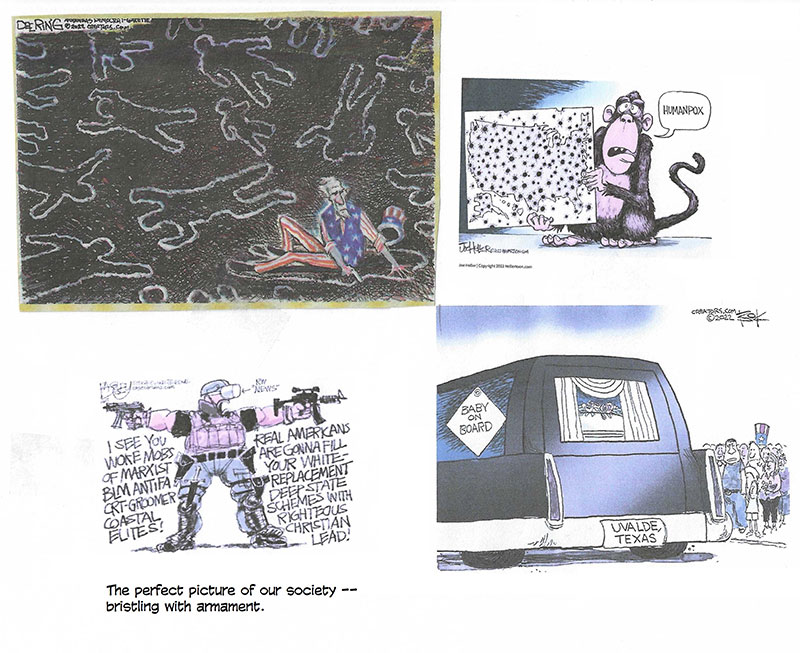

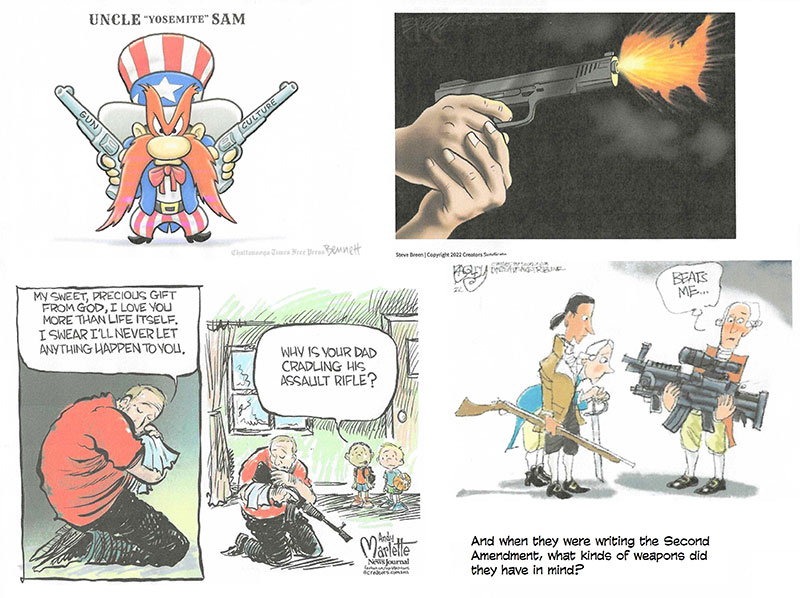
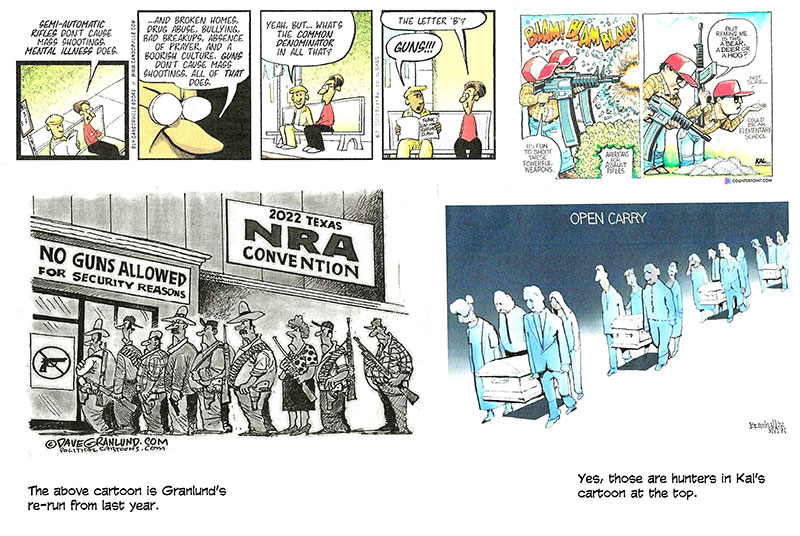
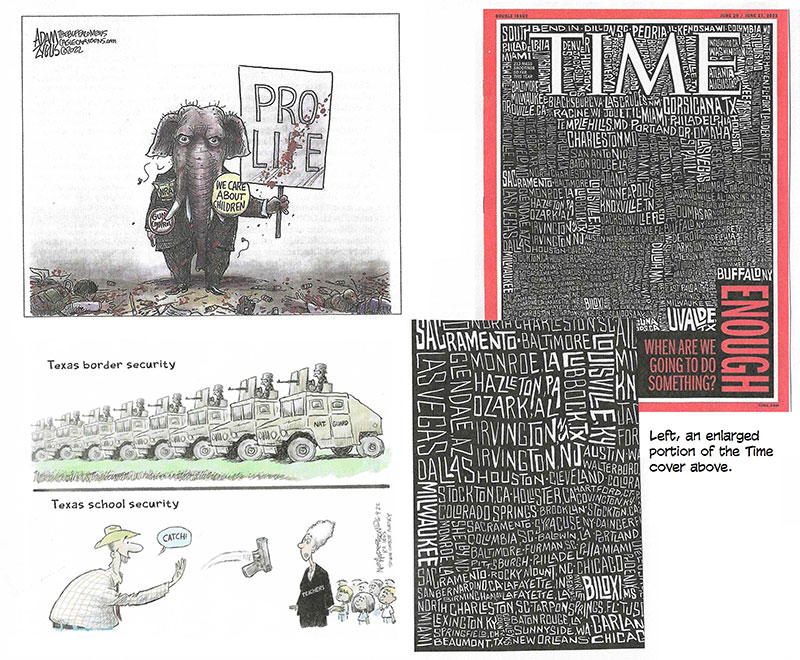
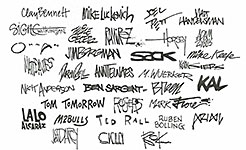

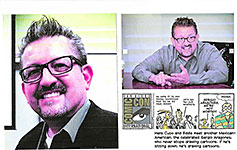
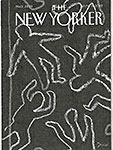
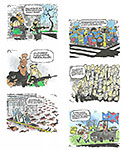
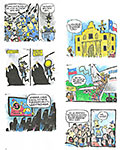

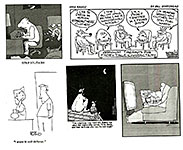
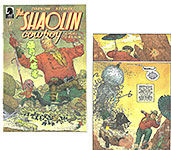
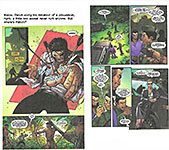
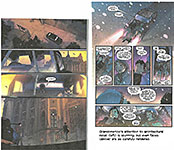
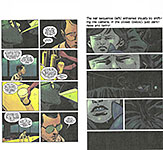
1.jpg)
2.jpg)
3.jpg)
4.jpg)
5.jpg)
6.jpg)
7.jpg)
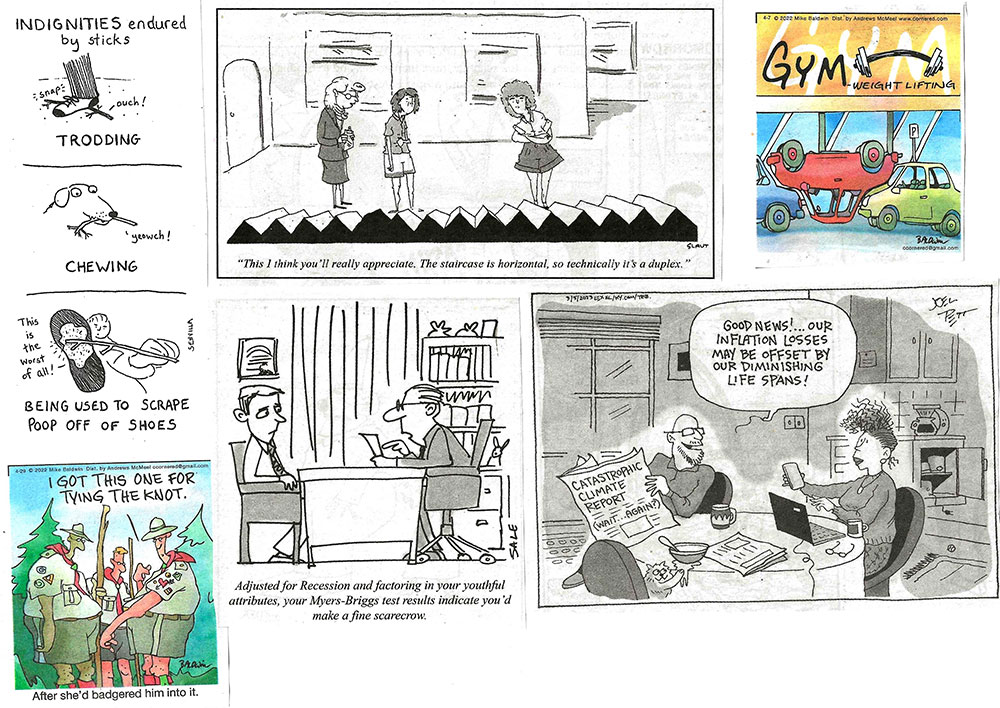
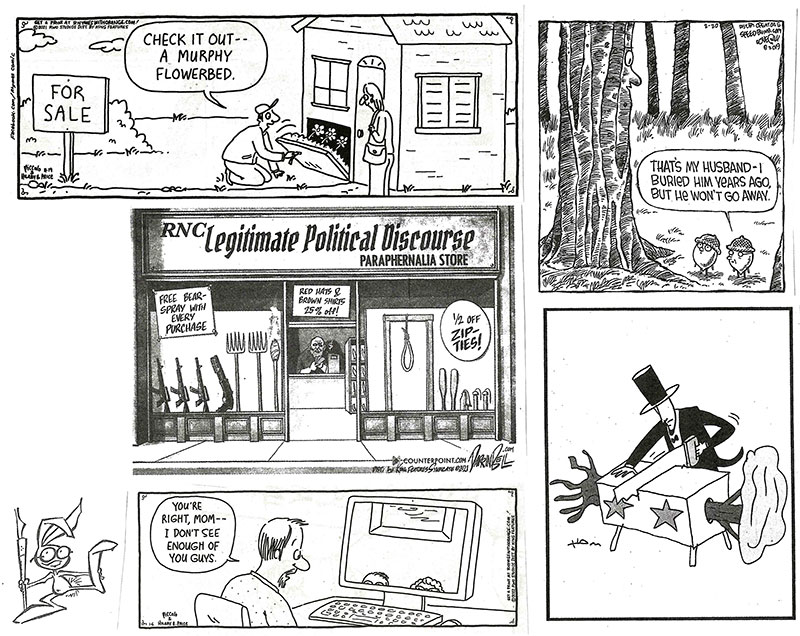
8.jpg)
9.jpg)
10.jpg)
11.jpg)
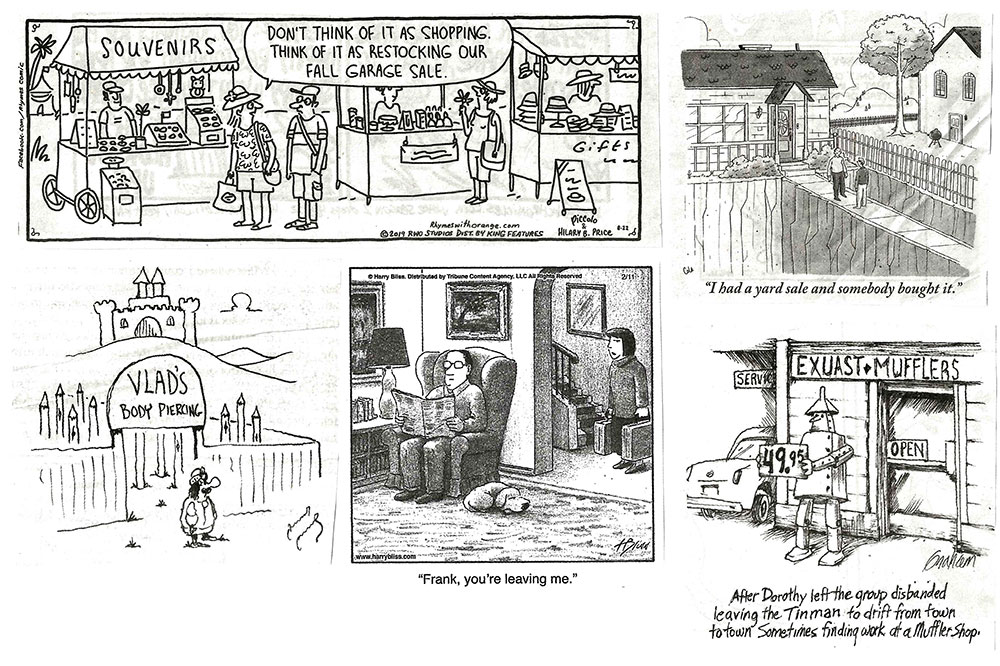
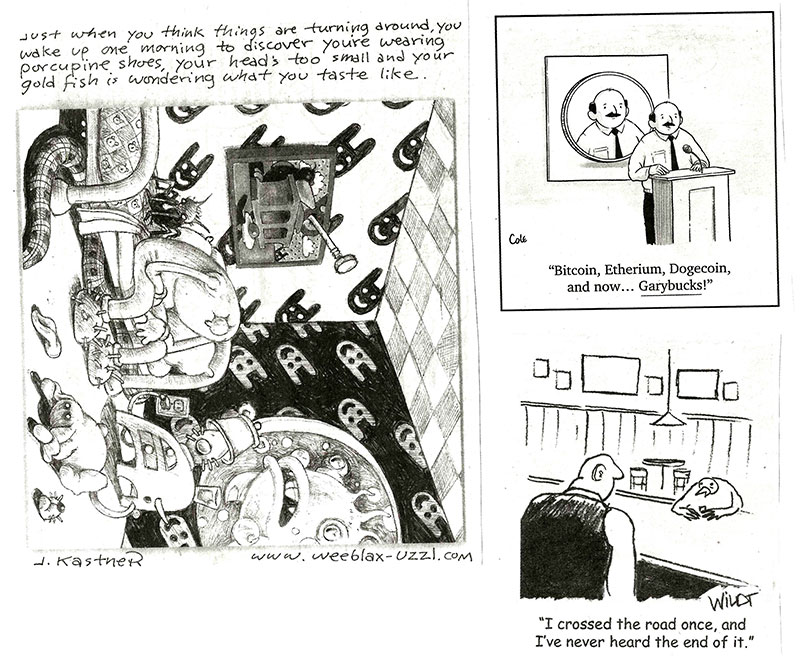
12.jpg)
13.jpg)
14.jpg)
15.jpg)
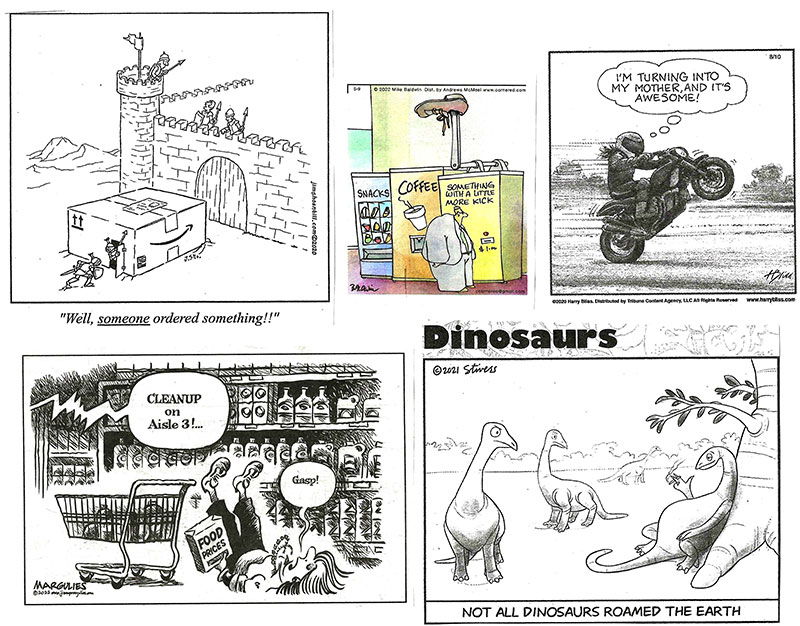
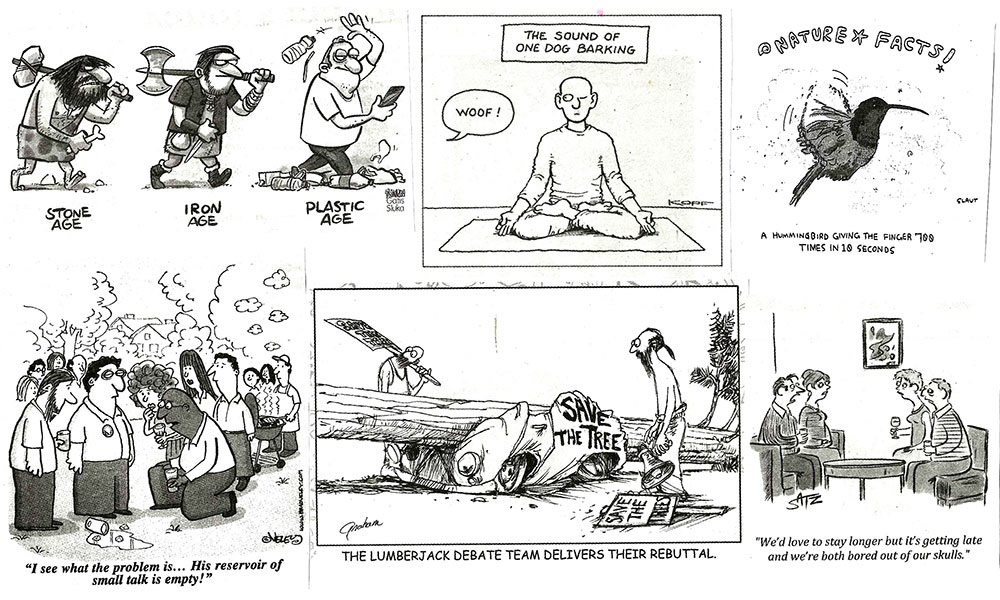
17.jpg)
18.jpg)
19.jpg)
20.jpg)
1.jpg)
2.jpg)
3.jpg)
4.jpg)
